
- Andhra Pradesh
- Chhattisgarh
- West Bengal
- Madhya Pradesh
- Maharashtra
- Jammu & Kashmir
- NCERT Books 2022-23
- NCERT Solutions
- NCERT Notes
- NCERT Exemplar Books
- NCERT Exemplar Solution
- States UT Book
- School Kits & Lab Manual
- NCERT Books 2021-22
- NCERT Books 2020-21
- NCERT Book 2019-2020
- NCERT Book 2015-2016
- RD Sharma Solution
- TS Grewal Solution
- DK Goel Solution
- TR Jain Solution
- Selina Solution
- Frank Solution
- ML Aggarwal Solution
- Lakhmir Singh and Manjit Kaur Solution
- I.E.Irodov solutions
- ICSE - Goyal Brothers Park
- ICSE - Dorothy M. Noronhe
- Sandeep Garg Textbook Solution
- Micheal Vaz Solution
- S.S. Krotov Solution
- Evergreen Science
- KC Sinha Solution
- ICSE - ISC Jayanti Sengupta, Oxford
- ICSE Focus on History
- ICSE GeoGraphy Voyage
- ICSE Hindi Solution
- ICSE Treasure Trove Solution
- Thomas & Finney Solution
- SL Loney Solution
- SB Mathur Solution
- P Bahadur Solution
- Narendra Awasthi Solution
- MS Chauhan Solution
- LA Sena Solution
- Integral Calculus Amit Agarwal Solution
- IA Maron Solution
- Hall & Knight Solution
- Errorless Solution
- Pradeep's KL Gogia Solution
- OP Tandon Solutions
- Sample Papers
- Previous Year Question Paper
- Value Based Questions
- CBSE Syllabus
- CBSE MCQs PDF
- Assertion & Reason
- New Revision Notes
- Revision Notes
- HOTS Question
- Marks Wise Question
- Toppers Answer Sheets
- Exam Paper Aalysis
- Concept Map
- CBSE Text Book
- Additional Practice Questions
- Vocational Book
- CBSE - Concept
- KVS NCERT CBSE Worksheets
- Formula Class Wise
- Formula Chapter Wise
- JEE Crash Course
- JEE Previous Year Paper
- Important Info
- JEE Mock Test
- SRM-JEEE Mock Test
- VITEEE Mock Test
- BITSAT Mock Test
- Manipal Engineering Mock Test
- AP EAMCET Previous Year Paper
- COMEDK Previous Year Paper
- GUJCET Previous Year Paper
- KCET Previous Year Paper
- KEAM Previous Year Paper
- Manipal Previous Year Paper
- MHT CET Previous Year Paper
- WBJEE Previous Year Paper
- AMU Previous Year Paper
- TS EAMCET Previous Year Paper
- SRM-JEEE Previous Year Paper
- VITEEE Previous Year Paper
- BITSAT Previous Year Paper
- Crash Course
- Previous Year Paper
- NCERT Based Short Notes
- NCERT Based Tests
- NEET Sample Paper
- Previous Year Papers
- Quantitative Aptitude
- Numerical Aptitude Data Interpretation
- General Knowledge
- Mathematics
- Agriculture
- Accountancy
- Business Studies
- Political science
- Enviromental Studies
- Mass Media Communication
- Teaching Aptitude
- NAVODAYA VIDYALAYA
- SAINIK SCHOOL (AISSEE)
- Mechanical Engineering
- Electrical Engineering
- Electronics & Communication Engineering
- Civil Engineering
- Computer Science Engineering
- CBSE Board News
- Scholarship Olympiad
- School Admissions
- Entrance Exams
- All Board Updates
- Miscellaneous
- State Wise Books
- Engineering Exam

CBSE Class 9th Maths 2023 : 30 Most Important Case Study Questions with Answers; Download PDF

SHARING IS CARING If our Website helped you a little, then kindly spread our voice using Social Networks. Spread our word to your readers, friends, teachers, students & all those close ones who deserve to know what you know now.
CBSE Class 9 Maths exam 2022-23 will have a set of questions based on case studies in the form of MCQs. CBSE Class 9 Maths Question Bank on Case Studies given in this article can be very helpful in understanding the new format of questions.
Each question has five sub-questions, each followed by four options and one correct answer. Students can easily download these questions in PDF format and refer to them for exam preparation.
CBSE Class 9 All Students can also Download here Class 9 Other Study Materials in PDF Format.

- NCERT Solutions for Class 12 Maths
- NCERT Solutions for Class 10 Maths
- CBSE Syllabus 2023-24
- Social Media Channels
- Login Customize Your Notification Preferences
- CBSE Class 9th 2023-24 : Science Practical Syllabus; Download PDF 19 April, 2023, 4:52 pm
- CBSE Class 9 Maths Practice Book 2023 (Released By CBSE) 23 March, 2023, 6:16 pm
- CBSE Class 9 Science Practice Book 2023 (Released By CBSE) 23 March, 2023, 5:56 pm
- CBSE Class 9th Maths 2023 : 30 Most Important Case Study Questions with Answers; Download PDF 10 February, 2023, 6:20 pm
- CBSE Class 9th Maths 2023 : Important Assertion Reason Question with Solution Download Pdf 9 February, 2023, 12:16 pm
- CBSE Class 9th Exam 2023 : Social Science Most Important Short Notes; Download PDF 16 January, 2023, 4:29 pm
- CBSE Class 9th Mathematics 2023 : Most Important Short Notes with Solutions 27 December, 2022, 6:05 pm
- CBSE Class 9th English 2023 : Chapter-wise Competency-Based Test Items with Answer; Download PDF 21 December, 2022, 5:16 pm
- CBSE Class 9th Science 2023 : Chapter-wise Competency-Based Test Items with Answers; Download PDF 20 December, 2022, 5:37 pm

- Second click on the toggle icon

Provide prime members with unlimited access to all study materials in PDF format.
Allow prime members to attempt MCQ tests multiple times to enhance their learning and understanding.
Provide prime users with access to exclusive PDF study materials that are not available to regular users.

CBSE Case Study Questions for Class 9 Maths - Pdf PDF Download
Cbse case study questions for class 9 maths.
CBSE Case Study Questions for Class 9 Maths are a type of assessment where students are given a real-world scenario or situation and they need to apply mathematical concepts to solve the problem. These types of questions help students to develop their problem-solving skills and apply their knowledge of mathematics to real-life situations.
Chapter Wise Case Based Questions for Class 9 Maths
The CBSE Class 9 Case Based Questions can be accessed from Chapetrwise Links provided below:
Chapter-wise case-based questions for Class 9 Maths are a set of questions based on specific chapters or topics covered in the maths textbook. These questions are designed to help students apply their understanding of mathematical concepts to real-world situations and events.
Chapter 1: Number System
- Case Based Questions: Number System
Chapter 2: Polynomial
- Case Based Questions: Polynomial
Chapter 3: Coordinate Geometry
- Case Based Questions: Coordinate Geometry
Chapter 4: Linear Equations
- Case Based Questions: Linear Equations - 1
- Case Based Questions: Linear Equations -2
Chapter 5: Introduction to Euclid’s Geometry
- Case Based Questions: Lines and Angles
Chapter 7: Triangles
- Case Based Questions: Triangles
Chapter 8: Quadrilaterals
- Case Based Questions: Quadrilaterals - 1
- Case Based Questions: Quadrilaterals - 2
Chapter 9: Areas of Parallelograms
- Case Based Questions: Circles
Chapter 11: Constructions
- Case Based Questions: Constructions
Chapter 12: Heron’s Formula
- Case Based Questions: Heron’s Formula
Chapter 13: Surface Areas and Volumes
- Case Based Questions: Surface Areas and Volumes
Chapter 14: Statistics
- Case Based Questions: Statistics
Chapter 15: Probability
- Case Based Questions: Probability
Weightage of Case Based Questions in Class 9 Maths
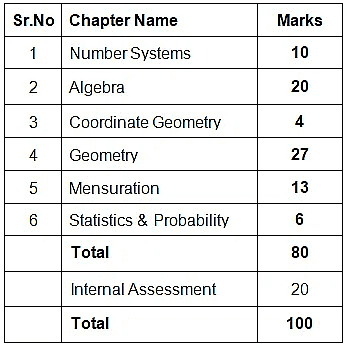
Why are Case Study Questions important in Maths Class 9?
- Enhance critical thinking: Case study questions require students to analyze a real-life scenario and think critically to identify the problem and come up with possible solutions. This enhances their critical thinking and problem-solving skills.
- Apply theoretical concepts: Case study questions allow students to apply theoretical concepts that they have learned in the classroom to real-life situations. This helps them to understand the practical application of the concepts and reinforces their learning.
- Develop decision-making skills: Case study questions challenge students to make decisions based on the information provided in the scenario. This helps them to develop their decision-making skills and learn how to make informed decisions.
- Improve communication skills: Case study questions often require students to present their findings and recommendations in written or oral form. This helps them to improve their communication skills and learn how to present their ideas effectively.
- Enhance teamwork skills: Case study questions can also be done in groups, which helps students to develop teamwork skills and learn how to work collaboratively to solve problems.
In summary, case study questions are important in Class 9 because they enhance critical thinking, apply theoretical concepts, develop decision-making skills, improve communication skills, and enhance teamwork skills. They provide a practical and engaging way for students to learn and apply their knowledge and skills to real-life situations.
Class 9 Maths Curriculum at Glance
The Class 9 Maths curriculum in India covers a wide range of topics and concepts. Here is a brief overview of the Maths curriculum at a glance:
- Number Systems: Students learn about the real number system, irrational numbers, rational numbers, decimal representation of rational numbers, and their properties.
- Algebra: The Algebra section includes topics such as polynomials, linear equations in two variables, quadratic equations, and their solutions.
- Coordinate Geometry: Students learn about the coordinate plane, distance formula, section formula, and slope of a line.
- Geometry: This section includes topics such as Euclid’s geometry, lines and angles, triangles, and circles.
- Trigonometry: Students learn about trigonometric ratios, trigonometric identities, and their applications.
- Mensuration: This section includes topics such as area, volume, surface area, and their applications.
- Statistics and Probability: Students learn about measures of central tendency, graphical representation of data, and probability.
The Class 9 Maths curriculum is designed to provide a strong foundation in mathematics and prepare students for higher education in the field. The curriculum is structured to develop critical thinking, problem-solving, and analytical skills, and to promote the application of mathematical concepts in real-life situations. The curriculum is also designed to help students prepare for competitive exams and develop a strong mathematical base for future academic and professional pursuits.
Students can also access Case Based Questions of all subjects of CBSE Class 9
- Case Based Questions for Class 9 Science
- Case Based Questions for Class 9 Social Science
- Case Based Questions for Class 9 English
- Case Based Questions for Class 9 Hindi
- Case Based Questions for Class 9 Sanskrit
Frequently Asked Questions (FAQs) on Case Based Questions for Class 9 Maths
What is case-based questions.
Case-Based Questions (CBQs) are open-ended problem solving tasks that require students to draw upon their knowledge of Maths concepts and processes to solve a novel problem. CBQs are often used as formative or summative assessments, as they can provide insights into how students reason through and apply mathematical principles in real-world problems.
What are case-based questions in Maths?
Case-based questions in Maths are problem-solving tasks that require students to apply their mathematical knowledge and skills to real-world situations or scenarios.
What are some common types of case-based questions in class 9 Maths?
Common types of case-based questions in class 9 Maths include word problems, real-world scenarios, and mathematical modeling tasks.
Top Courses for Class 9
Faqs on cbse case study questions for class 9 maths - pdf, video lectures, objective type questions, sample paper, shortcuts and tricks, viva questions, extra questions, study material, cbse case study questions for class 9 maths - pdf, important questions, semester notes, past year papers, mock tests for examination, previous year questions with solutions, practice quizzes.

CBSE Case Study Questions for Class 9 Maths - Pdf Free PDF Download
Importance of cbse case study questions for class 9 maths - pdf, cbse case study questions for class 9 maths - pdf notes, cbse case study questions for class 9 maths - pdf class 9, study cbse case study questions for class 9 maths - pdf on the app, welcome back, create you account for free.

Forgot Password
Unattempted tests, change country.

Case Study Questions for Class 9 Maths
- Post author: studyrate
- Post published:
- Post category: class 9th
- Post comments: 0 Comments
Are you preparing for your Class 9 Maths board exams and looking for an effective study resource? Well, you’re in luck! In this article, we will provide you with a collection of Case Study Questions for Class 9 Maths specifically designed to help you excel in your exams. These questions are carefully curated to cover various mathematical concepts and problem-solving techniques. So, let’s dive in and explore these valuable resources that will enhance your preparation and boost your confidence.
Join our Telegram Channel, there you will get various e-books for CBSE 2024 Boards exams for Class 9th, 10th, 11th, and 12th.

CBSE Class 9 Maths Board Exam will have a set of questions based on case studies in the form of MCQs. The CBSE Class 9 Mathematics Question Bank on Case Studies, provided in this article, can be very helpful to understand the new format of questions. Share this link with your friends.
If you want to want to prepare all the tough, tricky & difficult questions for your upcoming exams, this is where you should hang out. CBSE Case Study Questions for Class 9 will provide you with detailed, latest, comprehensive & confidence-inspiring solutions to the maximum number of Case Study Questions covering all the topics from your NCERT Text Books !
Table of Contents
CBSE Class 9th – MATHS: Chapterwise Case Study Question & Solution
Case study questions are a form of examination where students are presented with real-life scenarios that require the application of mathematical concepts to arrive at a solution. These questions are designed to assess students’ problem-solving abilities, critical thinking skills, and understanding of mathematical concepts in practical contexts.
Chapterwise Case Study Questions for Class 9 Maths
Case study questions play a crucial role in the field of mathematics education. They provide students with an opportunity to apply theoretical knowledge to real-world situations, thereby enhancing their comprehension of mathematical concepts. By engaging with case study questions, students develop the ability to analyze complex problems, make connections between different mathematical concepts, and formulate effective problem-solving strategies.
- Case Study Questions for Chapter 1 Number System
- Case Study Questions for Chapter 2 Polynomials
- Case Study Questions for Chapter 3 Coordinate Geometry
- Case Study Questions for Chapter 4 Linear Equations in Two Variables
- Case Study Questions for Chapter 5 Introduction to Euclid’s Geometry
- Case Study Questions for Chapter 6 Lines and Angles
- Case Study Questions for Chapter 7 Triangles
- Case Study Questions for Chapter 8 Quadilaterals
- Case Study Questions for Chapter 9 Areas of Parallelograms and Triangles
- Case Study Questions for Chapter 10 Circles
- Case Study Questions for Chapter 11 Constructions
- Case Study Questions for Chapter 12 Heron’s Formula
- Case Study Questions for Chapter 13 Surface Area and Volumes
- Case Study Questions for Chapter 14 Statistics
- Case Study Questions for Chapter 15 Probability
The above Case studies for Class 9 Mathematics will help you to boost your scores as Case Study questions have been coming in your examinations. These CBSE Class 9 Maths Case Studies have been developed by experienced teachers of schools.studyrate.in for benefit of Class 10 students.
- Class 9 Science Case Study Questions
- Class 9 Social Science Case Study Questions
How to Approach Case Study Questions
When tackling case study questions, it is essential to adopt a systematic approach. Here are some steps to help you approach and solve these types of questions effectively:
- Read the case study carefully: Understand the given scenario and identify the key information.
- Identify the mathematical concepts involved: Determine the relevant mathematical concepts and formulas applicable to the problem.
- Formulate a plan: Devise a plan or strategy to solve the problem based on the given information and mathematical concepts.
- Solve the problem step by step: Apply the chosen approach and perform calculations or manipulations to arrive at the solution.
- Verify and interpret the results: Ensure the solution aligns with the initial problem and interpret the findings in the context of the case study.
Tips for Solving Case Study Questions
Here are some valuable tips to help you effectively solve case study questions:
- Read the question thoroughly and underline or highlight important information.
- Break down the problem into smaller, manageable parts.
- Visualize the problem using diagrams or charts if applicable.
- Use appropriate mathematical formulas and concepts to solve the problem.
- Show all the steps of your calculations to ensure clarity.
- Check your final answer and review the solution for accuracy and relevance to the case study.
Benefits of Practicing Case Study Questions
Practicing case study questions offers several benefits that can significantly contribute to your mathematical proficiency:
- Enhances critical thinking skills
- Improves problem-solving abilities
- Deepens understanding of mathematical concepts
- Develops analytical reasoning
- Prepares you for real-life applications of mathematics
- Boosts confidence in approaching complex mathematical problems
Case study questions offer a unique opportunity to apply mathematical knowledge in practical scenarios. By practicing these questions, you can enhance your problem-solving abilities, develop a deeper understanding of mathematical concepts, and boost your confidence for the Class 9 Maths board exams. Remember to approach each question systematically, apply the relevant concepts, and review your solutions for accuracy. Access the PDF resource provided to access a wealth of case study questions and further elevate your preparation.
Q1: Can case study questions help me score better in my Class 9 Maths exams?
Yes, practicing case study questions can significantly improve your problem-solving skills and boost your performance in exams. These questions offer a practical approach to understanding mathematical concepts and their real-life applications.
Q2: Are the case study questions in the PDF resource relevant to the Class 9 Maths syllabus?
Absolutely! The PDF resource contains case study questions that align with the Class 9 Maths syllabus. They cover various topics and concepts included in the curriculum, ensuring comprehensive preparation.
Q3: Are the solutions provided for the case study questions in the PDF resource?
Yes, the PDF resource includes solutions for each case study question. You can refer to these solutions to validate your answers and gain a better understanding of the problem-solving process.
You Might Also Like
Class 9 mcq questions for chapter 5 the fundamental unit of life with answers, cbse class 9 science term 1 mcq questions with answers pdf download, class 9 mcq questions for chapter 9 force and laws of motion with answers, leave a reply cancel reply.
Save my name, email, and website in this browser for the next time I comment.
myCBSEguide
- Mathematics
- CBSE Class 9 Mathematics...
CBSE Class 9 Mathematics Case Study Questions
Table of Contents
myCBSEguide App
Download the app to get CBSE Sample Papers 2023-24, NCERT Solutions (Revised), Most Important Questions, Previous Year Question Bank, Mock Tests, and Detailed Notes.
If you’re looking for a comprehensive and reliable study resource and case study questions for class 9 CBSE, myCBSEguide is the perfect door to enter. With over 10,000 study notes, solved sample papers and practice questions, it’s got everything you need to ace your exams. Plus, it’s updated regularly to keep you aligned with the latest CBSE syllabus . So why wait? Start your journey to success with myCBSEguide today!
Significance of Mathematics in Class 9
Mathematics is an important subject for students of all ages. It helps students to develop problem-solving and critical-thinking skills, and to think logically and creatively. In addition, mathematics is essential for understanding and using many other subjects, such as science, engineering, and finance.
CBSE Class 9 is an important year for students, as it is the foundation year for the Class 10 board exams. In Class 9, students learn many important concepts in mathematics that will help them to succeed in their board exams and in their future studies. Therefore, it is essential for students to understand and master the concepts taught in Class 9 Mathematics .
Case studies in Class 9 Mathematics
A case study in mathematics is a detailed analysis of a particular mathematical problem or situation. Case studies are often used to examine the relationship between theory and practice, and to explore the connections between different areas of mathematics. Often, a case study will focus on a single problem or situation and will use a variety of methods to examine it. These methods may include algebraic, geometric, and/or statistical analysis.
Example of Case study questions in Class 9 Mathematics
The Central Board of Secondary Education (CBSE) has included case study questions in the Class 9 Mathematics paper. This means that Class 9 Mathematics students will have to solve questions based on real-life scenarios. This is a departure from the usual theoretical questions that are asked in Class 9 Mathematics exams.
The following are some examples of case study questions from Class 9 Mathematics:
Class 9 Mathematics Case study question 1
There is a square park ABCD in the middle of Saket colony in Delhi. Four children Deepak, Ashok, Arjun and Deepa went to play with their balls. The colour of the ball of Ashok, Deepak, Arjun and Deepa are red, blue, yellow and green respectively. All four children roll their ball from centre point O in the direction of XOY, X’OY, X’OY’ and XOY’ . Their balls stopped as shown in the above image.
Answer the following questions:
Answer Key:
Class 9 Mathematics Case study question 2
- Now he told Raju to draw another line CD as in the figure
- The teacher told Ajay to mark ∠ AOD as 2z
- Suraj was told to mark ∠ AOC as 4y
- Clive Made and angle ∠ COE = 60°
- Peter marked ∠ BOE and ∠ BOD as y and x respectively
Now answer the following questions:
- 2y + z = 90°
- 2y + z = 180°
- 4y + 2z = 120°
- (a) 2y + z = 90°
Class 9 Mathematics Case study question 3
- (a) 31.6 m²
- (c) 513.3 m³
- (b) 422.4 m²
Class 9 Mathematics Case study question 4
How to Answer Class 9 Mathematics Case study questions
To crack case study questions, Class 9 Mathematics students need to apply their mathematical knowledge to real-life situations. They should first read the question carefully and identify the key information. They should then identify the relevant mathematical concepts that can be applied to solve the question. Once they have done this, they can start solving the Class 9 Mathematics case study question.
Students need to be careful while solving the Class 9 Mathematics case study questions. They should not make any assumptions and should always check their answers. If they are stuck on a question, they should take a break and come back to it later. With some practice, the Class 9 Mathematics students will be able to crack case study questions with ease.
Class 9 Mathematics Curriculum at Glance
At the secondary level, the curriculum focuses on improving students’ ability to use Mathematics to solve real-world problems and to study the subject as a separate discipline. Students are expected to learn how to solve issues using algebraic approaches and how to apply their understanding of simple trigonometry to height and distance problems. Experimenting with numbers and geometric forms, making hypotheses, and validating them with more observations are all part of Math learning at this level.
The suggested curriculum covers number systems, algebra, geometry, trigonometry, mensuration, statistics, graphing, and coordinate geometry, among other topics. Math should be taught through activities that include the use of concrete materials, models, patterns, charts, photographs, posters, and other visual aids.
CBSE Class 9 Mathematics (Code No. 041)
Class 9 Mathematics question paper design
The CBSE Class 9 mathematics question paper design is intended to measure students’ grasp of the subject’s fundamental ideas. The paper will put their problem-solving and analytical skills to the test. Class 9 mathematics students are advised to go through the question paper pattern thoroughly before they start preparing for their examinations. This will help them understand the paper better and enable them to score maximum marks. Refer to the given Class 9 Mathematics question paper design.
QUESTION PAPER DESIGN (CLASS 9 MATHEMATICS)
Mycbseguide: blessing in disguise.
Class 9 is an important milestone in a student’s life. It is the last year of high school and the last chance to score well in the CBSE board exams. myCBSEguide is the perfect platform for students to get started on their preparations for Class 9 Mathematics. myCBSEguide provides comprehensive study material for all subjects, including practice questions, sample papers, case study questions and mock tests. It also offers tips and tricks on how to score well in exams. myCBSEguide is the perfect door to enter for class 9 CBSE preparations.
Test Generator
Create question paper PDF and online tests with your own name & logo in minutes.
Question Bank, Mock Tests, Exam Papers, NCERT Solutions, Sample Papers, Notes
Related Posts
- Competency Based Learning in CBSE Schools
- Class 11 Physical Education Case Study Questions
- Class 11 Sociology Case Study Questions
- Class 12 Applied Mathematics Case Study Questions
- Class 11 Applied Mathematics Case Study Questions
- Class 11 Mathematics Case Study Questions
- Class 11 Biology Case Study Questions
- Class 12 Physical Education Case Study Questions
14 thoughts on “CBSE Class 9 Mathematics Case Study Questions”
This method is not easy for me
aarti and rashika are two classmates. due to exams approaching in some days both decided to study together. during revision hour both find difficulties and they solved each other’s problems. aarti explains simplification of 2+ ?2 by rationalising the denominator and rashika explains 4+ ?2 simplification of (v10-?5)(v10+ ?5) by using the identity (a – b)(a+b). based on above information, answer the following questions: 1) what is the rationalising factor of the denominator of 2+ ?2 a) 2-?2 b) 2?2 c) 2+ ?2 by rationalising the denominator of aarti got the answer d) a) 4+3?2 b) 3+?2 c) 3-?2 4+ ?2 2+ ?2 d) 2-?3 the identity applied to solve (?10-?5) (v10+ ?5) is a) (a+b)(a – b) = (a – b)² c) (a – b)(a+b) = a² – b² d) (a-b)(a+b)=2(a² + b²) ii) b) (a+b)(a – b) = (a + b
MATHS PAAGAL HAI
All questions was easy but search ? hard questions. These questions was not comparable with cbse. It was totally wastage of time.
Where is search ? bar
maths is love
Can I have more questions without downloading the app.
I love math
Hello l am Devanshu chahal and l am an entorpinior. I am started my card bord business and remanded all the existing things this all possible by math now my business is 120 crore and my business profit is 25 crore in a month. l find the worker team because my business is going well Thanks
Leave a Comment
Save my name, email, and website in this browser for the next time I comment.
Join NOW to get access to exclusive study material for best results
- Case Study Questions
Please Login or Sign up to continue!
Triangles Case Study Questions (CSQ’s)
Select the number of questions for the test:
Instructions
- Keep paper and pencil ready but keep your books away.
- Click the "Begin Test" button to start the test.
- You can move between questions and answer them in any order you like.
- Click on "End Test" when you are done.
- These tests are unlimited in nature…take as many as you like.
- You will be able to view the solutions only after you end the test.
All the best – Happy Studying!
Kindly subscribe to continue
Get in Touch
Call / Whats App
- - Class 11 Science
- - Class 11 Commerce
- - Class 12 Science
- - Class 12 Commerce
Talk to our experts
1800-120-456-456
- NCERT Solutions for Class 9 Maths Chapter 7 - Triangles
- NCERT Solutions

Free PDF Download - NCERT Solutions for Class 9 Maths Chapter 7
Vedantu.com, India's leading online tutoring platform, offers a complimentary PDF download of NCERT Solutions for Class 9 Maths Chapter 7 - Triangles. These solutions, crafted by adept teachers in accordance with NCERT (CBSE) guidelines, cover all exercise questions. Accessing these solutions aids in comprehensive syllabus revision and improved scoring in assessments. Register for our free webinar class with the best mathematics tutor in India.

Exercises under NCERT Solutions for Class 9 Maths Chapter 7 Triangles
NCERT Solutions for Class 9 Maths Chapter 7, "Triangles," is a crucial chapter for students as it provides the basic foundation for higher-level geometry. The chapter mainly focuses on the properties and theorems of triangles, their congruence, and their similarity. There are five exercises in this chapter, and each of them deals with different kinds of questions related to triangles. Here's a brief overview of each exercise:
Exercise 7.1: This exercise comprises eight questions, and it mainly deals with the basic properties of triangles such as interior angles, exterior angles, and inequalities. The questions are mostly objective and require students to apply simple formulas to find the values of angles and sides of triangles.
Exercise 7.2: This exercise consists of eight questions and mainly focuses on the congruence of triangles. The questions in this exercise deal with the criteria for congruence of triangles such as SSS, SAS, ASA, RHS, and AAS. The questions require students to apply these criteria to determine if the given triangles are congruent or not.
Exercise 7.3: This exercise comprises five questions, and it deals with the properties of isosceles and equilateral triangles. The questions in this exercise require students to apply the properties of these triangles to find the values of angles and sides.
Exercise 7.4: This exercise consists of six questions and mainly focuses on the inequalities in triangles. The questions in this exercise deal with the triangle inequality theorem and the converse of the same. The questions require students to apply these theorems to determine if a triangle can be formed with the given sides or not.
Exercise 7.5: This exercise comprises four questions and deals with the similarity of triangles. The questions in this exercise require students to apply the criteria for the similarity of triangles such as AA, SAS, and SSS. The questions require students to find the values of the sides and angles of similar triangles.
Access NCERT Answers for Class-9 Maths Chapter 7 – Triangles
Exercise-7.1
1. In quadrilateral ACBD, AC = AD and AB bisects \[\angle A\] (See the given figure). Show that \[\Delta ABC{\text{ }} \cong \Delta ABD\]. What can you say about BC and BD?

Quadrilateral ABCD
Ans: Given: In quadrilateral ACBD, AC = AD and AB is bisected by \[\angle A\]
To find: Show that \[\Delta ABC{\text{ }} \cong \Delta ABD\].
In \[\Delta ABC{\text{ , }}\Delta ABD\]
\[AC{\text{ }} = {\text{ }}AD\] (Given)
\[\angle CAB{\text{ }} = \angle DAB\] (AB bisects ∠A)
\[AB{\text{ }} = {\text{ }}AB\] (Common)
\[\therefore \Delta ABC{\text{ }} \cong \Delta ABD\] (By SAS congruence rule)
\[\therefore BC{\text{ }} = {\text{ }}BD\] (By CPCT)
Therefore, BC and BD are of equal lengths.
2. ABCD is a quadrilateral in which AD = BC and \[\angle DAB{\text{ }} = \angle CBA\] (See the given figure). Prove that
(i) \[\Delta ABD{\text{ }} \cong \Delta BAC\]
(ii) BD = AC
(iii)\[\angle ABD{\text{ }} = \angle BAC\].

Quadrilateral ABCD with AD = BC
Ans : Given: ABCD is a quadrilateral where AD = BC and \[\angle DAB{\text{ }} = \angle CBA\]
To prove:
In \[\Delta ABD{\text{ , }}\Delta BAC\],
AD = BC (Given)
\[\angle DAB{\text{ }} = \angle CBA\] (Given)
AB = BA (Common)
\[\therefore \Delta ABD{\text{ }} \cong \Delta BAC\] (By SAS congruence rule)
\[\therefore BD{\text{ }} = {\text{ }}AC\] (By CPCT)
And, \[\angle ABD{\text{ }} = \angle BAC\] (By CPCT)
3. AD and BC are equal perpendiculars to a line segment AB (See the given figure). Show that CD bisects AB.

Figure showing AD and BC equal perpendiculars to a line segment AB
Ans: Given: AD and BC are equal perpendiculars to a line segment AB
To prove: CD bisects AB.
In \[\Delta BOC{\text{ , }}\Delta AOD\],
\[\angle BOC{\text{ }} = \angle AOD\] (Vertically opposite angles)
\[\angle CBO{\text{ }} = \angle DAO\] (Each right angle )
BC = AD (Given)
\[\therefore \Delta BOC{\text{ }} \cong \Delta AOD\] (AAS congruence rule)
\[\therefore BO{\text{ }} = {\text{ }}AO\] (By CPCT)
\[ \Rightarrow \]CD bisects AB.
4. l and m are two parallel lines intersected by another pair of parallel lines p and q (see the given figure). Show that \[\Delta ABC \cong \Delta CDA\].

Two Parallel Lines L and M
Given: l and m are two parallel lines intersected by another pair of parallel lines p and q To prove: \[\Delta ABC \cong \Delta CDA\].
In \[\Delta ABC{\text{ , }}\Delta CDA\],
\[\angle BAC{\text{ }} = \angle DCA\] (Alternate interior angles, as\[p{\text{ }}||{\text{ }}q\])
2AC = CA (Common)
\[\angle BCA{\text{ }} = \angle DAC\] (Alternate interior angles, as \[l{\text{ }}||{\text{ }}m\])
\[\therefore \Delta ABC \cong \Delta CDA\] (By ASA congruence rule)
5. Line l is the bisector of an angle \[\angle A\] and B is any point on l. BP and BQ are $$perpendiculars from B to the arms of \[\angle A\] (see the given figure). Show that:

Line l the Bisector of an Angle A
(i) \[\Delta APB \cong \Delta AQB\]
(ii) BP = BQ or B is equidistant from the arms of ∠A.
Ans: Given: Line l is the bisector of an angle \[\angle A\] and B is any point on l.
To prove: (i) \[\Delta APB \cong \Delta AQB\]
(ii) \[BP{\text{ }} = {\text{ }}BQ\] or B is equidistant from the arms of \[\angle A\].
In \[\Delta APB{\text{ , }}\Delta AQB\],
\[\angle APB{\text{ }} = \angle AQB\] (Each right angle )
\[\angle PAB{\text{ }} = \angle QAB\] (l is the angle bisector of \[\angle A\])
AB = AB (Common)
\[\therefore \Delta APB \cong \Delta AQB\] (By AAS congruence rule)
\[\therefore BP{\text{ }} = {\text{ }}BQ\] (By CPCT)
Or, it can be said that B is equidistant from the arms of \[\angle A\].
6. In the given figure, \[AC{\text{ }} = {\text{ }}AE,{\text{ }}AB{\text{ }} = {\text{ }}AD\] and \[\angle BAD{\text{ }} = \angle EAC\]. Show that BC = DE.

Angle BAD = angle EAC
Given: \[\angle BAD{\text{ }} = \angle EAC\]
To prove: BC = DE
It is given that \[\angle BAD{\text{ }} = \angle EAC\]
\[\angle BAD{\text{ }} + \angle DAC{\text{ }} = \angle EAC{\text{ }} + \angle DAC\]
\[\angle BAC{\text{ }} = \angle DAE\]
In \[\Delta BAC{\text{ , }}\Delta DAE\],
AB = AD (Given)
\[\angle BAC{\text{ }} = \angle DAE\] (Proved above)
AC = AE (Given)
\[\therefore \Delta BAC{\text{ }} \cong \Delta DAE\] (By SAS congruence rule)
\[\therefore BC{\text{ }} = {\text{ }}DE\] (By CPCT)
7. AB is a line segment and P is its mid-point. D and E are points on the same side of AB such that \[\angle BAD{\text{ }} = \angle ABE\] and \[\angle EPA{\text{ }} = \angle DPB\] (See the given figure). Show that

Line segment AB with its mid point P
(i) \[\Delta DAP \cong \Delta EBP\]
(ii) AD = BE
Ans: Given: AB is a line segment and P is its mid-point. D and E are points on the same side of AB such that \[\angle BAD{\text{ }} = \angle ABE\] and \[\angle EPA{\text{ }} = \angle DPB\]
To prove: (i) \[\Delta DAP \cong \Delta EBP\]
It is given that \[\angle EPA{\text{ }} = \angle DPB\]
\[\angle EPA{\text{ }} + \angle DPE{\text{ }} = \angle DPB{\text{ }} + \angle DPE\]
\[\therefore \angle DPA{\text{ }} = \angle EPB\]
In \[\Delta DAP{\text{ , }}\Delta EBP\],
\[\angle DAP{\text{ }} = \angle EBP\] (Given)
AP = BP (P is mid-point of AB)
\[\angle DPA{\text{ }} = \angle EPB\] (From above)
\[\therefore \Delta DAP \cong \Delta EBP\] (ASA congruence rule)
\[\therefore AD{\text{ }} = {\text{ }}BE\] (By CPCT)
8. In right triangle ABC, right angled at C, M is the mid-point of hypotenuse AB. C is joined to M and produced to a point D such that DM = CM. Point D is joined to point B (see the given figure). Show that:

Triangle ABC right - angled at C and midpoint M of AB
i) \[\Delta AMC \cong \Delta BMD\]
ii) \[\angle DBC\] is a right angle.
iii) \[\Delta DBC \cong \Delta ACB\]
iv) \[CM{\text{ }} = {\text{ }}\dfrac{1}{2}{\text{ }}AB\]
Ans: Given: M is the mid-point of hypotenuse AB. DM = CM
(i) In \[\Delta AMC{\text{ }},{\text{ }}\Delta BMD\],
AM = BM (M is the mid-point of AB)
\[\angle AMC{\text{ }} = \angle BMD\] (Vertically opposite angles)
CM = DM (Given)
\[\therefore \Delta AMC \cong \Delta BMD\] (By SAS congruence rule)
\[\therefore AC{\text{ }} = {\text{ }}BD\] (By CPCT)
And, \[\angle ACM{\text{ }} = \angle BDM\](By CPCT)
(ii) \[\angle ACM{\text{ }} = \angle BDM\]
However, \[\angle ACM{\text{ , }}\angle BDM\] are alternate interior angles.
Since alternate angles are equal,
It can be said that \[DB{\text{ }}||{\text{ }}AC\]
(Co-interior angles)
(iii) In \[\Delta DBC{\text{ , }}\Delta ACB\],
DB = AC (Already proved)
\[\angle DBC{\text{ }} = \angle ACB\] (Each \[{90^o}\])
BC = CB (Common)
\[\therefore \Delta DBC \cong \Delta ACB\] (SAS congruence rule)
(iv) \[\therefore \Delta DBC \cong \Delta ACB\]
AB = DC (By CPCT)
\[CM{\text{ }} = {\text{ }}\dfrac{1}{2}{\text{ }}AB\]
Exercise (7.2)
1. In an isosceles triangle ABC, with AB = AC, the bisectors of ∠B and ∠C intersect each other at O. Join A to O. Show that:
(i) OB = OC (ii) AO bisects ∠A

Isosceles triangle with AB = AC
Ans: We know, $\angle ABC = \angle ACB$ ${\text{[Equal angles of isosceles triangle]}}$
$ \Rightarrow \dfrac{1}{2}\angle ABC = \dfrac{1}{2}ACB$
$ \Rightarrow \angle OBC = \angle OCB$
$\therefore OB = OC$ ${\text{[Sides opposite to equal angles of Isosceles triangle are equal]}}$
Now, In $\Delta ABO$ and $\Delta ACO$,
$AB = AC$ ${\text{[Equal sides of Isosceles triangle]}}$
$OB = OC$ ${\text{[Proved above]}}$
AO=AO [Common]
$\therefore \Delta ABO \cong \Delta ACO$ ${\text{[By SSS]}}$
$\therefore \angle BAO = \angle CAO$ ${\text{[CPCT]}}$
$\therefore $ AO bisects angle A.
2. In ΔABC, AD is the perpendicular bisector of BC (see the given figure). Show that ΔABC is an isosceles triangle in which AB = AC.

Triangle ABC , AD being the bisector of BC
Ans: $\because $ AD is perpendicular bisector of BC,
$\therefore $$BD = DC$
& $\angle ADB = \angle ADC$ ${\text{[Each 90°]}}$
Now, in$\Delta ABD$ and $\Delta ACD$,
$AD = AD$ (Common)
$\angle ADB = \angle ADC$ ${\text{[Proved above]}}$ $BD = CD$ ${\text{[Proved above]}}$
$\therefore \Delta ADB \cong \Delta ACD$ ${\text{[by SAS]}}$
$\therefore AB = AC$ (CPCT)
So, $\Delta ABC$ is an isosceles triangle with \[AB = AC\]
3. ABC is an isosceles triangle in which altitudes BE and CF are drawn to equal sides AC and AB respectively (see the given figure). Show that these altitudes are equal.

Isosceles triangle ABC
Ans: In $\Delta ABE$and $\Delta ACF$,
$\angle AEB = \angle AFE$ ${\text{[Each 90°]}}$
$\angle BAE = \angle CAF$ (Common)
$AB = AC$ [Given]
$\therefore \Delta ABE \cong \Delta ACF$ ${\text{[By AAS]}}$
$\therefore BE = CF$ (CPCT)
4. ABC is a triangle in which altitudes BE and CF to sides AC and AB are equal (see the given figure). Show that
(i) \[\Delta ABE \cong \Delta ACF\]
(ii) AB = AC i.e., ABC is an isosceles triangle

Triangle ABC with equal altitudes
\[\angle BAE = \angle CAF\] (Common)
$\angle BEA = \angle CFA$ ${\text{[Each 90°]}}$
$BE = CF$ [Given]
$\therefore \Delta ABE \cong \Delta ACF$ ${\text{[by AAS]}}$
And therefore, $\Delta ABC$ is an isosceles triangle with AB=AC.
5. ABC and DBC are two isosceles triangles on the same base BC (see the given figure). Show that ∠ABD = ∠ACD.

Two Isosceles Triangles
Ans: Since AB=AC, and DB=DC,
$\therefore $ABDC is a quadrilateral with adjacent sides being equal.
$ \Rightarrow $ABDC is a kite.
We know that one pair of opposite (obtuse) angles of kite are equal.
Hence, $\angle ABD = \angle ACD$
6. ΔABC is an isosceles triangle in which AB = AC. Side BA is produced to D such that AD = AB (see the given figure). Show that ∠BCD is a right angle.

Isosceles Triangle in which AB = AC
Ans: In $\Delta ABC$
$\angle ABC = \angle ACB$ ${\text{[angles opposite to equal sides of a triangle]}}$ … (1)
Similarly, in $\Delta ADC$
$\angle ADC = \angle ACD$ ${\text{[angles opposite to equal sides of a triangle]}}$ … (2)
Now since BD is a straight line,
$\angle BAC + \angle CAD = 180^\circ $ … (3)
And we know,
$\angle BAC = \angle ADC + \angle ACD$ ${\text{[Exterior angle of a triangle = sum of opposite interior angles]}}$
$ \Rightarrow \angle BAC = 2\angle ACD$ ${\text{[From 2]}}$ … (4)
$\angle CAD = \angle ABC + \angle ACB$
$ \Rightarrow \angle CAD = 2\angle ACB$ ${\text{[From 1]}}$ … (5)
$\therefore 2\angle ACB + 2\angle ACD = 180^\circ $ ${\text{[From 3, 4 and 5]}}$
$ \Rightarrow \angle ACB + \angle ACD = 90^\circ $
$ \Rightarrow \angle BCD = 90^\circ $
Hence proved.
7. ABC is a right-angled triangle in which ∠A = 90° and AB = AC. Find ∠B and ∠C.

Right - Angled Triangle ABC
Ans: Since AB = AC,
$\angle B = \angle C$ ${\text{[Angles opposite to equal sides of a triangle]}}$
Now, we know
$\angle A + \angle B + \angle C = 180^\circ $ ${\text{[Angle sum property]}}$
$ \Rightarrow \angle A + 2\angle C = 180^\circ $
$ \Rightarrow 90^\circ + 2\angle C = 180^\circ $
$ \Rightarrow 2\angle C = 90^\circ $
$ \Rightarrow \angle C = 45^\circ $
$\therefore \angle B = 45^\circ $
Hence $\angle B$ and $\angle C$ are each 45$^\circ $
8. Show that the angles of an equilateral triangle are 60º each.

Equilateral Triangle
In $\angle B = \angle C$ ${\text{[Angles opposite to equal sides of a triangle]}}$
$\angle A = \angle B$ ${\text{[Angles opposite to equal sides of a triangle]}}$
$ \Rightarrow \angle A = \angle B = \angle C$
Now, we know that
$ \Rightarrow \angle A + \angle A + \angle A = 180^\circ $
$\Rightarrow 3\angle A = 180^\circ $
$ \Rightarrow \angle A = 60^\circ $
$\therefore \angle A = \angle B = \angle C = 60^\circ $
Exercise 7.3
1. ΔABC and ΔDBC are two isosceles triangles on the same base BC and vertices A and D are on the same side of BC (see the given figure). If AD is extended to intersect BC at P, show that
(i) \[\Delta ABD \cong \Delta ACD\]
(ii) \[\Delta ABP \cong \Delta ACP\]
(iii) AP bisects $\angle A$ as well as $\angle D$
(iv)AP is the bisector of BC

Two Isosceles Triangle on the same Base
Ans: (i) In $\Delta ABD$ and $\Delta ACD$,
$AB = AC$ ${\text{[Equal sides of isosceles triangle]}}$
$DB = DC$ ${\text{[Equal sides of isosceles triangle]}}$
AD=AD (Common)
$\therefore \Delta ABD \cong \Delta ACD$ ${\text{[By SSS]}}$
$ \Rightarrow \angle BAD = \angle CAD$ [CPCT]
$ \Rightarrow \angle BAP = \angle CAP$ … (1)
And $\angle ADB = \angle ADC$ (CPCT) … (2)
(ii) In $\Delta ABP$ and $\Delta ACP$
$\angle BAP = \angle CAP$ ${\text{[From 1]}}$
$AP = AP$ (Common)
$\therefore \Delta ABP \cong \Delta ACP$ ${\text{[By SAS]}}$
$\therefore BP = CP$ (CPCT) … (3)
Similarly, $\angle APB = \angle APC$ (CPCT) … (4)
(iii) AP is bisector of $\angle A$ ${\text{[From 1]}}$
Now, since AP is a line segment
$\therefore \angle ADB + \angle BDP = 180^\circ $ … (5)
Similarly, $\angle ADC + \angle CDP = 180^\circ $ … (6)
Comparing equations 2, 5 and 6 we can say that
$\angle BDP = \angle CDP$
$\therefore $AP bisects $\angle D$
Hence AP bisects both $\angle A$ and $\angle D$
(iv)We know,
$\angle APB + \angle APC = 180^\circ $
$ \Rightarrow \angle APB + \angle APB = 180^\circ $ ${\text{[From 4]}}$
$ \Rightarrow \angle APB = 90^\circ $ … (7)
From equations 3 and 7 we can say that,
AP is perpendicular bisector of BC.
2. AD is an altitude of an isosceles triangles ABC in which AB = AC. Show that
(i) AD bisects BC
(ii) AD bisects $\angle A$

Isosceles Triangle BC with AB = AC
In $\Delta ADB$ and $\Delta ADC$
$AB = AC$ (Given)
$\angle ADB = \angle ADC$ ${\text{[Each 90°]}}$
$\therefore \Delta ADB \cong \Delta ADC$ ${\text{[By RHS]}}$
$ \Rightarrow BD = DC$ (CPCT)
Therefore, AD is bisector of BC
Similarly, $\angle BAD = \angle CAD$ (CPCT)
Therefore, AD bisects $\angle A$as well.
3. Two sides AB and BC and median AM of one triangle ABC are respectively equal to sides PQ and QR and median PN of ΔPQR (see the given figure). Show that:
(i)\[\Delta ABM \cong \Delta PQN\]
(ii)\[\Delta ABC \cong \Delta PQR\]

Two Triangles with Their Corresponding Parts
Ans: (i) We know that $BC = QR$ … (1)
Now, Since AM is median of ΔABC,
$ \Rightarrow BM = \dfrac{1}{2}BC$ … (2)
Similarly, PN is median of ΔPQR,
$ \Rightarrow QN = \dfrac{1}{2}QR$ … (3)
From equations 1, 2 and 3, we can say that,
$BM = QN$ … (4)
Now in $\Delta ABM$ and $\Delta PQN$
\[AB = PQ\] (Given)
\[BM = QN\] ${\text{[From 4]}}$
AM=PN (Given)
$\therefore \Delta ABM \cong \Delta PQN$ ${\text{[By SSS]}}$
$ \Rightarrow \angle ABM = \angle AQN$ (CPCT)
$ \Rightarrow \angle ABC = \angle PQR$ … (5)
(ii) Now in $\Delta ABC$ and $\Delta PQR$,
$AB = PQ$ (Given)
$\angle ABC = \angle PQR$ ${\text{[From 5]}}$
$BC = QR$ (Given)
\[\Delta ABC \cong \Delta PQR\] ${\text{[By SAS]}}$
4. BE and CF are two equal altitudes of a triangle ABC. Using RHS congruence rule, prove that the triangle ABC is isosceles.

Two Equal Altitudes BE and CF of Triangle ABC
In $\Delta BEC$ and $\Delta CFB$
$BE = CF$ (Given)
$\angle BEC = \angle CFB$ ${\text{[Each 90°]}}$
BC=CB (Common)
$\therefore \Delta BEC \cong \Delta CFB$ ${\text{[By RHS Congruency]}}$
$ \Rightarrow \angle BCE = \angle CBF$ (CPCT)
$\therefore AB = AC$ ${\text{[Sides opposite to equal angles of a triangle are equal]}}$
Therefore, ΔABC is an isosceles triangle.
5. ABC is an isosceles triangle with AB = AC. Draw AP ⊥ BC to show that ∠B= ∠C.

Isosceles Triangle ABC with AB = AC
Ans: In $\Delta ABP$ and $\Delta ACP$
$\angle APB = \angle APC$ ${\text{[Each 90°]}}$
$\therefore \Delta ABP \cong \Delta ACP$ ${\text{[By RHS]}}$
$ \Rightarrow \angle ABP = \angle ACP$ (CPCT)
Exercise 7.4
1. Show that in a right-angled triangle, the hypotenuse is the longest side.

Right - Angle Triangle ABC
Let us assume a right-angled triangle ABC with $\angle ABC = 90^\circ $.
Now, in $\Delta ABC$
$\angle BAC + \angle ABC + \angle ACB = 180^\circ $ ${\text{[Angle sum property]}}$
$ \Rightarrow \angle BAC + 90^\circ + \angle ACB = 180^\circ $
$ \Rightarrow \angle BAC + \angle ACB = 90^\circ $
So, clearly both $\angle BAC$ and $\angle ACB$ are smaller than $\angle ABC$
$ \Rightarrow $AB and BC are smaller than AC.
$\therefore $AC is the largest side in $\Delta ABC$.
And since AC is the hypotenuse of $\Delta ABC$,
Therefore, hypotenuse of any triangle is the largest side of that triangle.
2. In the given figure sides AB and AC of ΔABC are extended to points P and Q respectively. Also, ∠PBC < ∠QCB. Show that AC > AB.

AB and AC of ΔABC are Extended to Points P and Q
Ans: $\angle PBC + \angle ABC = 180^\circ $ ${\text{[Linear pair]}}$ … (1)
Similarly, $\angle QCB + \angle ACB = 180^\circ $ … (2)
Also, it is given that $\angle PBC < \angle QCB$ … (3)
Now, comparing equations 1, 2 and 3 we can say that
$\angle ABC > \angle ACB$
$\therefore AC > AB$ ${\text{[Sides opposite to larger angle of triangle are larger]}}$
3. In the given figure, ∠B < ∠A and ∠C < ∠D. Show that AD < BC.

An Angle B is Smaller than Angle A and an Angle C is Smaller than Angle D
Ans: Since $\angle B < \angle A$,
In $\Delta OAB$ , $OB > OA$ ${\text{[Sides opposite to larger angle of triangle are larger]}}$ … (1)
Similarly, in $\Delta ODC$ , $\angle D > \angle C$
$ \Rightarrow OC > OD$ … (2)
Adding equation 1 and 2, we get
$ OB + OC > OA + OD$
$ \Rightarrow BC > AD $
$\therefore AD < BC$
4. AB and CD are respectively the smallest and longest sides of a quadrilateral ABCD (see the given figure). Show that ∠A > ∠C and ∠B > ∠D.

Quadrilateral ABCD with Diagonal AC
Let us connect AC
In $\Delta ADC$,
$AD < DC$ ${\text{[DC is largest side]}}$
$\therefore \angle 4 < \angle 3$ ${\text{[Angles opposite to smaller side are smaller]}}$ … (1)
Similarly, In $\Delta ABC$
\[AB < BC\] ${\text{[AB is smallest side]}}$
$\therefore \angle 2 < \angle 3$ ${\text{[Angles opposite to smaller side are smaller]}}$ … (2)
Comparing equation 1 and 2, we can say that
$\angle 2 + \angle 4 < \angle 1 + \angle 3$
$ \Rightarrow \angle C < \angle A$
$\therefore \angle A > \angle C$
Now let us join BD.

Quadrilateral ABCD with Diagonal BD
In $\Delta BDC$
$BC < DC$ ${\text{[DC is largest side]}}$
$\therefore \angle 7 < \angle 6$ ${\text{[Angles opposite to smaller side are smaller]}}$ … (3)
Similarly, in $\Delta ABD$
$AB < AD$ ${\text{[AB is smallest side]}}$
$\therefore \angle 8 < \angle 5$ ${\text{[Angles opposite to smaller side are smaller]}}$ … (4)
Adding equations 3 and 4 we get that,
$\angle 7 + \angle 8 < \angle 6 + \angle 5$
$ \Rightarrow \angle D < \angle B$
$\therefore \angle B > \angle D$
Hence proved
5. In the given figure, PR > PQ and PS bisects ∠QPR. Prove that ∠PSR > ∠PSQ.

PR is Greater PQ and PS Bisects an Angle QPR
Ans: In $\Delta PQR$
$PR > PQ$ (Given)
$ \Rightarrow \angle Q > \angle R$ ${\text{[Angles opposite to larger side are larger]}}$ … (1)
Now in $\Delta PQS$
$\angle SPQ + \angle PQS + \angle QSP = 180^\circ $ … (2)
Similarly, in $\Delta PRS$
$\angle SPR + \angle PRS + \angle RSP = 180^\circ $ … (3)
Also, $\angle SPQ = \angle SPR$ [PS bisects $\angle P$] … (4)
Equating equations 2 and 3 we get that
$\angle SPQ + \angle PQS + \angle QSP = \angle SPR + \angle PRS + \angle RSP$
$ \Rightarrow \angle PQS + \angle QSP = \angle PRS + \angle RSP$ ${\text{[Using equation 4]}}$ … (5)
Comparing equation 5 and 1, we can say that
$\angle RSP > \angle QSP$
Hence $\angle PSR > \angle PSQ$.
6. Show that of all line segments drawn from a given point not on it, the perpendicular line segment is the shortest.

Right - Angles Triangle PMN
Let us take a line l and from point P (i.e., not on line l), draw two line segments PN and PM. Let PN be perpendicular to line l and PM is drawn at some other angle.
Now, $\Delta PNM$ is a right-angle triangle, right angled at $\angle N$
$ \Rightarrow PM$ is hypotenuse
And we know that hypotenuse is the largest side of right-angled triangle
$\therefore PM > PN$
Similarly, any line segment drawn from P to line l, except for PN will be larger than PN.
Therefore, we can say that perpendicular line segment drawn from a given point is the shortest.
Exercise 7.5
1. ABC is a triangle. Locate a point in the interior of ΔABC which is equidistant from all the vertices of ΔABC.
Ans: The circumcentre of a triangle is always equidistant from all of its vertices.
The circumcentre is the point where the perpendicular bisectors of all the triangle's sides meet.

Point O Equidistant from all the Vertices of ΔABC
By sketching the perpendicular bisectors of the triangle's sides AB, BC, and CA, we may determine the circumcentre in$\Delta ABC$. The intersection of these bisectors is marked by the letter O. As a result, O is the point that is equidistant from all of $\Delta ABC$'s vertices.
2. In a triangle locate a point in its interior which is equidistant from all the sides of the triangle.
Ans: The incentre of a triangle is the point that is equidistant from all the triangle's sides. The intersection point of the angle bisectors of a triangle's internal angles is the triangle's centre.

Point I Equidistant from all the Sides of the Triangle
By drawing the angle bisectors of the interior angles of this triangle in $\Delta ABC$, we may get the incentre of this triangle. I is the point at which these angle bisectors cross each other. As a result, I is the point that is equidistant from all of $\Delta ABC$'s sides.
3. In a huge park people are concentrated at three points (see the given figure)
(Image Will Be Updated Soon)
Figure showing three points A,B,C
A: where there are different slides and swings for children,
B: near which a man-made lake is situated,
C: which is near to a large parking and exit.
Where should an ice-cream parlour be set up so that maximum number of persons can approach it?
(Hint: The parlor should be equidistant from A, B and C)
Ans: If the ice cream parlour is equidistant from A, B, and C, the maximum number of people can approach it. A, B, and C now form a triangle. The circumcentre is the only point in a triangle that is equidistant from its vertices. As a result, the ice cream parlour should be located near ΔABC's circumcenter O.

perpendicular bisectors of sides AB ,BC,AC
The maximum amount of people can approach it in this case.
By drawing perpendicular bisectors of the sides of this triangle, we can find the circumcentre O.
4. Complete the hexagonal and star shaped rangolies (see the given figures) by filling them with as many equilateral triangles of side 1 cm as you can. Count the number of triangles in each case. Which has more triangles?

Hexagonal and star shaped Rangolies
Ans: We can see that hexagonal shaped rangoli has total of 6 equilateral triangles of side 5 cm in it.

Hexagonal with AB = 5cm
Whereas starshaped rangoli also has 6 equilateral triangles of side 5cm and a hexagon in middle.
Therefore, star-shaped rangoli will be filled with more equilateral triangles of side 1 cm in it.
NCERT Solutions for Class 9 Maths Chapter 7 Triangles - PDF Download
Learn more about class 9 maths chapter 7.
Before we talk about chapter 7 maths class 9 NCERT solutions, there are some important concepts related to this chapter that students should know about. Let’s start by talking about what congruent triangles are
The intersection of three lines forms a triangle, which is one of the most basic two-dimensional geometric shapes. The NCERT solutions for class 9 maths chapter 7 Triangles discuss triangle congruence, rules of congruence, and other properties, as well as triangle inequalities. This chapter begins with a brief introduction to the basic elements of a triangle so that students can understand triangles, their types, and properties. In addition, the NCERT solutions class 9 maths chapter 7 covers key formulas, questions, and theorems based on congruent triangles and triangle inequalities.
NCERT Solutions for Class 9 Maths Other Chapters PDF Download
Chapter 1 - Number System
Chapter 2 - Polynomials
Chapter 3 - Coordinate Geometry
Chapter 4 - Linear Equations in Two Variables
Chapter 5 - Introductions to Euclids Geometry
Chapter 6 - Lines and Angles
Chapter 8 - Quadrilaterals
Chapter 9 - Areas of Parallelogram and Triangles
Chapter 10 - Circles
Chapter 11 - Constructions
Chapter 12 - Herons formula
Chapter 13 - Surface area and Volumes
Chapter 14 - Statistics
Chapter 15 - Probability
According to chapter 7 class 9 maths NCERT solutions, congruent triangles are a pair of triangles in which all three sides are corresponding. In congruent triangles, the angles should also be equal or congruent.
(Image will be updated soon)
In congruent triangles, all the corresponding parts are equal. The triangles can be written as CPCT (Corresponding part of the congruent triangle).

The Criteria for Congruence
There are several criteria for congruence that students should know about. Those criteria are mentioned below.
SSS Criteria for Congruence
This criterion stands true if all the three sides of one triangle are equal to the three sides of the other triangle. This means that the two triangles are completely congruent. Also, if all the sides of the triangle are the same, then their corresponding angles should also be the same.
SAS Criteria for Congruence
This is an important criterion that is required for writing NCERT solutions for class 9 maths triangles. According to this criterion, the two triangles are congruent if the two sides and the included angle on the triangle are equal to the corresponding sides. The included angle of the other triangle is also equal.
ASA Criteria for Congruence
The two triangles are congruent if the two angles and the included side of the one triangle is equal to the corresponding two angles and the included side of the other triangle.
AAS Criteria for Congruence
The two triangles are congruent to one another if the two angles and one side of one triangle are equal to the side of the other triangle and the two angles.
The Reason why AAA and SSA Congruence Rules are not Valid
Students should know about the reason why AAA and SSA congruence rules are not valid for writing NCERT solutions for class 9 chapter 7. The ASS and SSA test is not a valid test for congruency because the angle is not included between the pairs of the equal sides.
The AAA test is also not valid even though the two triangles can have all the three same angles. The sides can be of various lengths. It can also become a test for similarity (AA).
RHS Criteria for Congruence
If in two right triangles, the hypotenuse and the one side of one triangle are equal to the one side of the other triangle and the hypotenuse, then the two triangles are congruent. Also, in this criteria for congruence, RHS stands for Right Angle Hypotenuse Side.
Properties of Isosceles Triangle
Students should also learn about the properties of isosceles triangles for writing NCERT solutions of class 9 maths chapter 7. The most important property is that if the two sides of the triangle are equal, the angles opposite those sides are also equal and vice versa is also true.
The Inequalities in Triangles
The unequal sides of the triangle and the angles opposite are related as if the two sides of a triangle are unequal, then the angles opposite to the longer side will be larger than the angle opposite to the shorter side.
Triangle Inequality
According to various NCERT class 9 maths solutions chapter 7, the sum of the lengths of any two sides of a triangle must be larger than the third side.
Triangles Class 9 NCERT Solutions PDF Free Download
Students can download NCERT solutions for class 9 maths chapter triangles from Vedantu. The class 9 ch 7 maths solutions can be downloaded for free. These solutions are written by the most talented experts in India. These solutions will help students to score better marks than ever.
This means that students can pass their final examination with flying colors. Also, in exercise 7.1, there are eight questions. In exercise 7.2, there are eight questions. In exercise 7.3, there are five questions. In exercise 7.4, there are six questions, and in exercise 7.5, there are four questions.
Weightage Marks for CBSE Class 9 Maths Chapter 7 Triangles
Why should you download ncert class 9 maths chapter 7 solutions from vedantu.
There are many reasons why you should download NCERT solutions maths class 9 chapter 7 from Vedantu. And some of those reasons are mentioned below.
All answers are written according to the guidelines set by CBSE
Students can learn answers quickly and easily
All answers are provided with an explanation section. This explanation section help students to understand the reasoning behind arriving at the answer
The answers are written by the best subject matter experts in India
The NCERT solutions for class 9th maths chapter 7 are available for free
In Class 9 Maths NCERT Solutions Chapter 7 - Triangles, students grasp fundamental concepts like triangle properties, congruence rules, inequality criteria, angle sums, and side lengths. Vedantu's exercises in the form of NCERT Solutions for this chapter serve as a valuable resource for comprehending these concepts effectively.

FAQs on NCERT Solutions for Class 9 Maths Chapter 7 - Triangles
1. What does class 9th maths chapter 7 include?
In class 9th maths chapter 7, students get to learn about triangles. In this chapter, the different properties of triangles are discussed, along with the meaning of triangles. The criteria for inequalities of triangles are also mentioned. The chapter ends with a discussion on the rules of congruence of triangles.
2. What are some important topics of Class 9 maths chapter 7 solutions?
Some important topics of class 9 maths chapter 7 are:
Congruence of triangle
Properties of triangle
Inequalities of triangle
Rules of congruence of triangle
3. From where can I download NCERT solutions class 9 maths chapter 7?
Students can download NCERT solutions from Vedantu for free. To download the solutions, all you have to do is simply install the Vedantu app.
4. What are the properties of triangles?
There are six main properties of triangles. And these properties are:
In a triangle, the angle opposite to the longer side is greater
In a triangle, the side that is opposite to the greater angle is longer
The sum of any two sides of a triangle is greater than the third side
Every angle of an equilateral triangle measures to be 60 degrees
The sides opposite to equal angles of a triangle are equal
The angles opposite to equal sides of a triangle are equal
5. Are there any practice exercises available in NCERT Solutions for Chapter 7?
Yes, NCERT Solutions typically include practice exercises with step-by-step solutions. These exercises help you reinforce your understanding and improve your problem-solving skills.
6. Is it essential to memorize the theorems and properties mentioned in this chapter?
While memorization can be helpful, it's more important to understand the underlying principles and how to apply them. Focus on grasping the concepts, and you'll find it easier to remember the theorems and properties.
7. Can I use NCERT Solutions as a primary study resource for Class 9 Mathematics Chapter 7?
NCERT Solutions are an excellent primary study resource, but it's also beneficial to refer to other textbooks, practice additional problems, and seek clarifications from teachers when needed to gain a more comprehensive understanding of the chapter.
NCERT Solutions for Class 9 Maths
Ncert solutions for class 9.

Gurukul of Excellence
Classes for Physics, Chemistry and Mathematics by IITians
Category: Case Study Questions for Class 9 Maths
Join our Telegram Channel for Free PDF Download
Case Study Questions for Class 9 Maths Chapter 12 Herons Formula
Case study questions for class 9 maths chapter 9 areas of parallelograms and triangles, case study questions for class 9 maths chapter 6 lines and angles, case study questions for class 9 maths chapter 7 triangles, case study questions for class 9 maths chapter 5 introduction to euclid’s geometry, case study and passage based questions for class 9 maths chapter 14 statistics, case study questions for class 9 maths chapter 1 real numbers, case study questions for class 9 maths chapter 4 linear equations in two variables, case study questions for class 9 maths chapter 3 coordinate geometry, case study questions for class 9 maths chapter 15 probability, case study questions for class 9 maths chapter 13 surface area and volume, case study questions for class 9 maths chapter 10 circles, case study questions for class 9 maths chapter 9 quadrilaterals, case study questions for class 9 maths chapter 2 polynomials.
Join our Online Test Series for CBSE, ICSE, JEE, NEET and Other Exams

Editable Study Materials for Your Institute - CBSE, ICSE, State Boards (Maharashtra & Karnataka), JEE, NEET, FOUNDATION, OLYMPIADS, PPTs
NCERT Solutions Class 9 Maths Chapter 7 Triangles
Triangle is one of the most basic two-dimensional geometric shapes formed by the intersection of three lines. The NCERT solutions for class 9 maths chapter 7 Triangles talk about the congruence of triangles, rules of congruence, and some more properties along with triangle inequalities. This chapter starts with a brief introduction to the basic elements of a triangle for students to have a clear understanding of triangles , their types, and properties. Further, the NCERT solutions class 9 maths chapter 7 cover important formulas, questions, and theorems based on congruent triangles and triangle inequalities .
The major takeaway for the students from the class 9 maths NCERT solutions chapter 7 triangle would be the properties of triangles, rules of congruence, and criteria for inequalities, including some facts and theorems related to the sum of the angles and length of their sides. Chapter 7 Triangles are highly beneficial in learning all these concepts with the help of exercises available in the pdf links below and also find some of these in the exercises given below.
- NCERT Solutions Class 9 Maths Chapter 7 Ex 7.1
- NCERT Solutions Class 9 Maths Chapter 7 Ex 7.2
- NCERT Solutions Class 9 Maths Chapter 7 Ex 7.3
- NCERT Solutions Class 9 Maths Chapter 7 Ex 7.4
- NCERT Solutions Class 9 Maths Chapter 7 Ex 7.5
NCERT Solutions for Class 9 Maths Chapter 7 PDF
The NCERT solutions for class 9 maths chapter 7 Triangle has a total of five exercises that explains the topics mentioned above. It will help enhance the students’ knowledge about triangles and their properties. These exercises are easily accessible through the given links.
☛ Download Class 9 Maths NCERT Solutions Chapter 7 Triangles
NCERT Class 9 Maths Chapter 7 Download PDF
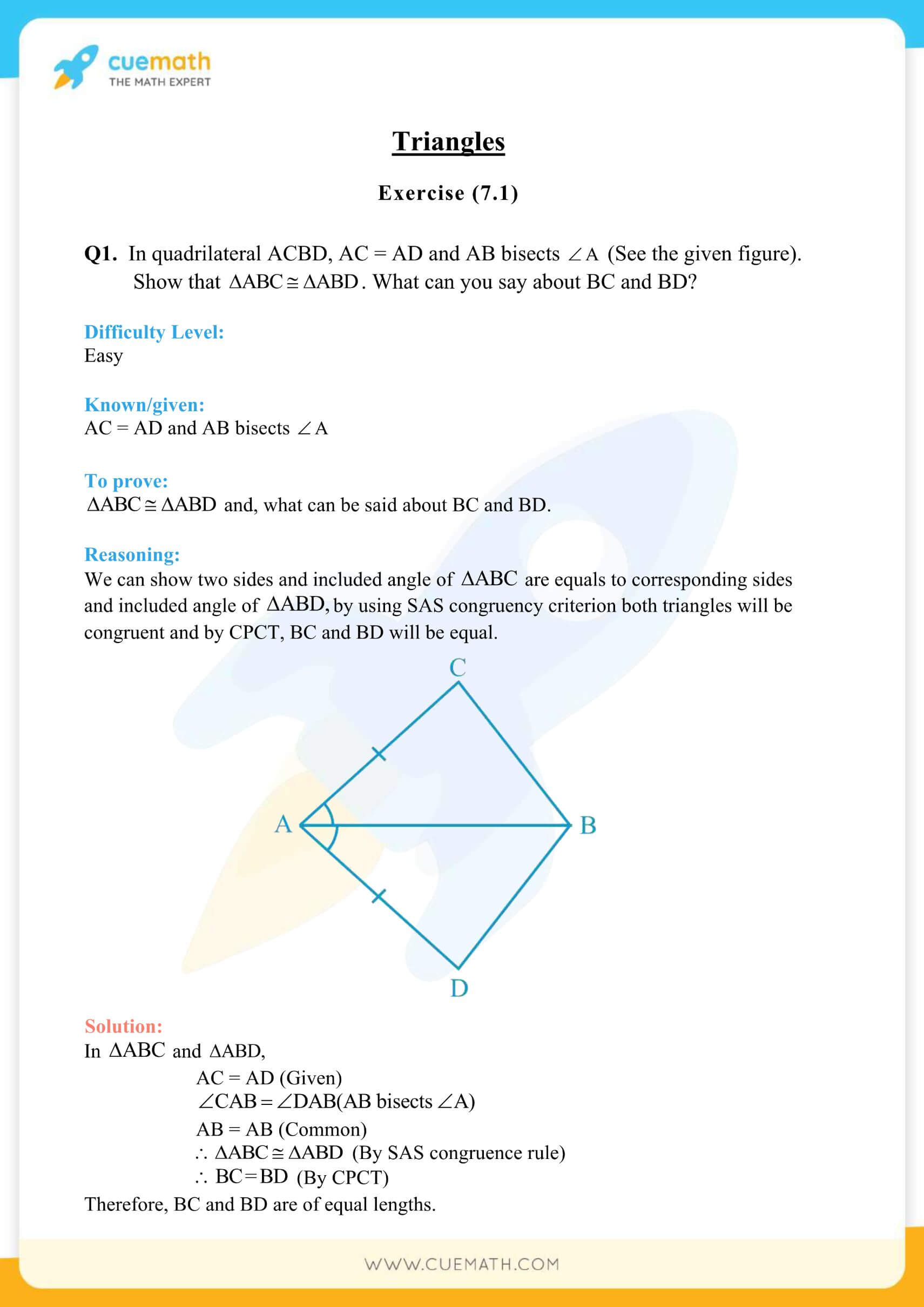
Triangle is an explicit geometric shape that is required to understand various complex concepts such as congruency in triangles. Two triangles are said to be congruent to each other if they have equal sides and angles . Thus, it is vital to gain a deep understanding of the basic properties of triangles. Having a sound knowledge of triangles will also ensure a strong base for future geometry studies. Students can use these class 9 NCERT solutions maths chapter 7 to build their fundamental understanding of triangles and the questions in each section. The links to the detailed exercise-wise questions are listed below:
- Class 9 Maths Chapter 7 Ex 7.1 - 8 Questions
- Class 9 Maths Chapter 7 Ex 7.2 - 8 Questions
- Class 9 Maths Chapter 7 Ex 7.3 - 5 Questions
- Class 9 Maths Chapter 7 Ex 7.4 - 6 Questions
- Class 9 Maths Chapter 7 Ex 7.5 - 4 Questions
☛ Download Class 9 Maths Chapter 7 NCERT Book
Topics Covered: The topics that the class 9 maths NCERT solutions chapter 7 covers are congruence of triangles, criteria for congruence of triangles, some properties of the triangle, and inequalities in a triangle. Additionally, the theorem on angle sums and sides are explained with the help of suitable examples and sample problems.
Total Questions: Class 9 maths chapter 7 Triangle comprises 31 questions. Out of these 29 involve providing certain conditions based on congruence and inequalities of triangles, while the remaining 3 involve the construction of geometric figures that will help students to have practical knowledge of this topic.
List of Formulas in NCERT Solutions Class 9 Maths Chapter 7
There are a few congruency rules that the students must take note of from the NCERT solutions class 9 maths chapter 7. The rules are-- the SAS congruence rule, ASA congruence rule, SSS congruence rule, and RHS congruence rule. These four rules can be summarized as below:
- SAS Congruence Rule: Two triangles are congruent if their two sides and an angle between these sides are equal to each other.
- ASA Congruence Rule: Two triangles are congruent if two angles and the included side of one triangle are equal to two angles and the included side of the other triangle.
- SSS Congruence Rule: : If three sides of one triangle are equal to the three sides of another triangle, then the two triangles are congruent.
- RHS Congruence Rule: If in two right triangles the hypotenuse and one side of one triangle are equal to the hypotenuse and one side of the other triangle, then the two triangles are congruent.
Important Questions for Class 9 Maths NCERT Solutions Chapter 7
Video solutions for class 9 maths ncert chapter 7, faqs on ncert solutions class 9 maths chapter 7, why are ncert solutions for class 9 maths chapter 7 important.
The National Council of Educational Research and Training (NCERT) is renowned for imparting quality education for years. These solutions are designed as per the NCERT books after thorough research to ensure the best results. NCERT Solutions Class 9 Maths are well-formed in a simple format to deliver precise information on each topic. NCERT Solutions Class 9 Maths are also recommended by CBSE for exam preparation.
How Many Questions are there in NCERT Solutions Class 9 Maths Chapter 7?
There are 31 questions in the NCERT Solutions Class 9 Maths Chapter 7 Triangle. Out of these 29 are based on proving triangles congruence and inequalities. The rest of the three questions are the instructions to construct triangles that are a must to understand this topic.
What are the Important Topics Covered in Class 9 Maths NCERT Solutions Chapter 7?
The important topics that the NCERT Solutions Class 9 Maths Chapter 7 covers are the types of triangles, related terms, definitions, important properties, congruency, and inequality of triangles. Apart from these, the theorems based on the angle sum property and the length of the triangle’s sides are explained in these solutions.
Why Should I Practice NCERT Solutions Class 9 Maths Triangles chapter 7?
NCERT Solutions Class 9 Maths Triangle chapter 7 will make the students confident by enhancing the fundamental knowledge of triangles and their properties. As all the concepts of triangles are clearly explained with the help of sample problems, these resources are ideal for establishing step-by-step learning required to score well in exams and for competitive studies.
Do I Need to Practice all Questions Provided in Class 9 maths NCERT Solutions Triangles?
NCERT Solutions Class 9 Maths Triangle are carefully framed around the properties of triangles and their congruency. Students can better understand this topic by solving all the problems readily available in these solutions. It will also help to boost the curiosity and learnability of students.
What are the Important Formulas in NCERT Solutions for Class 9 Maths Chapter 7?
The NCERT solutions class 9 maths chapter 7 contains important theorems, definitions, terms, and rules related to congruence in triangles that students must memorize. Some of these criteria are SAS, ASA, SSS, and RHS congruence rules. Some other important concepts included in these solutions are the angle sum property stating that the sum of the three angles of a triangle is always equal to 180 degrees .
NCERT Solutions for Class 9 Maths Chapter 7 Triangles
NCERT Solutions for Class 9 Maths Chapter 7 Triangles are provided here. Our NCERT Maths solutions contain all the questions of the NCERT textbook that are solved and explained beautifully. Here you will get complete NCERT Solutions for Class 9 Maths Chapter 7 all exercises Exercise in one place. These solutions are prepared by the subject experts and as per the latest NCERT syllabus and guidelines. CBSE Class 9 Students who wish to score good marks in the maths exam must practice these questions regularly.
Class 9 Maths Chapter 7 Triangles NCERT Solutions
Below we have provided the solutions of each exercise of the chapter. Go through the links to access the solutions of exercises you want. You should also check out our NCERT Class 9 Solutions for other subjects to score good marks in the exams.
NCERT Solutions for Class 9 Maths Chapter 7 Exercise 7.1
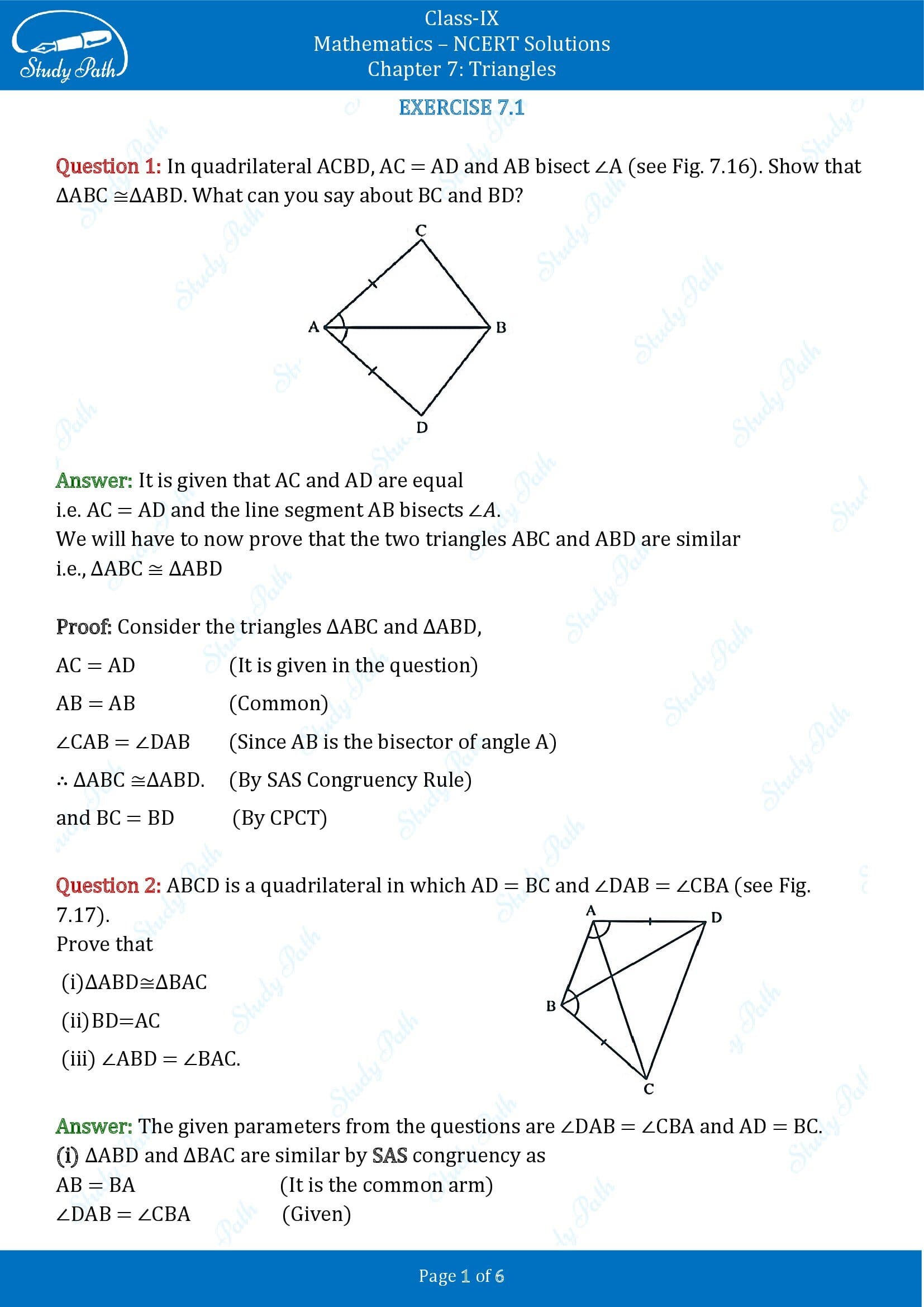
NCERT Solutions for Class 9 Maths Chapter 7 Exercise 7.2
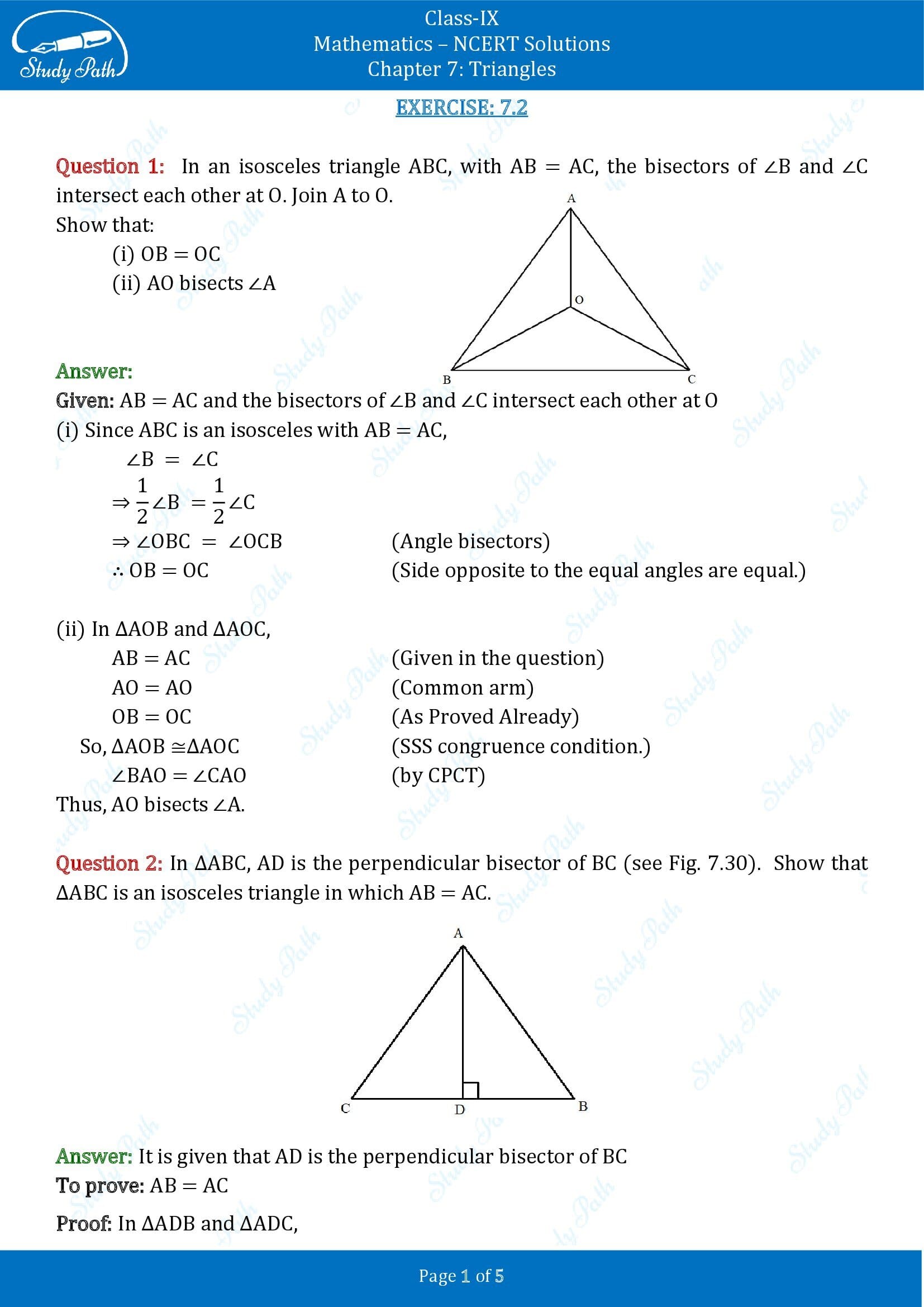
NCERT Solutions for Class 9 Maths Chapter 7 Exercise 7.3
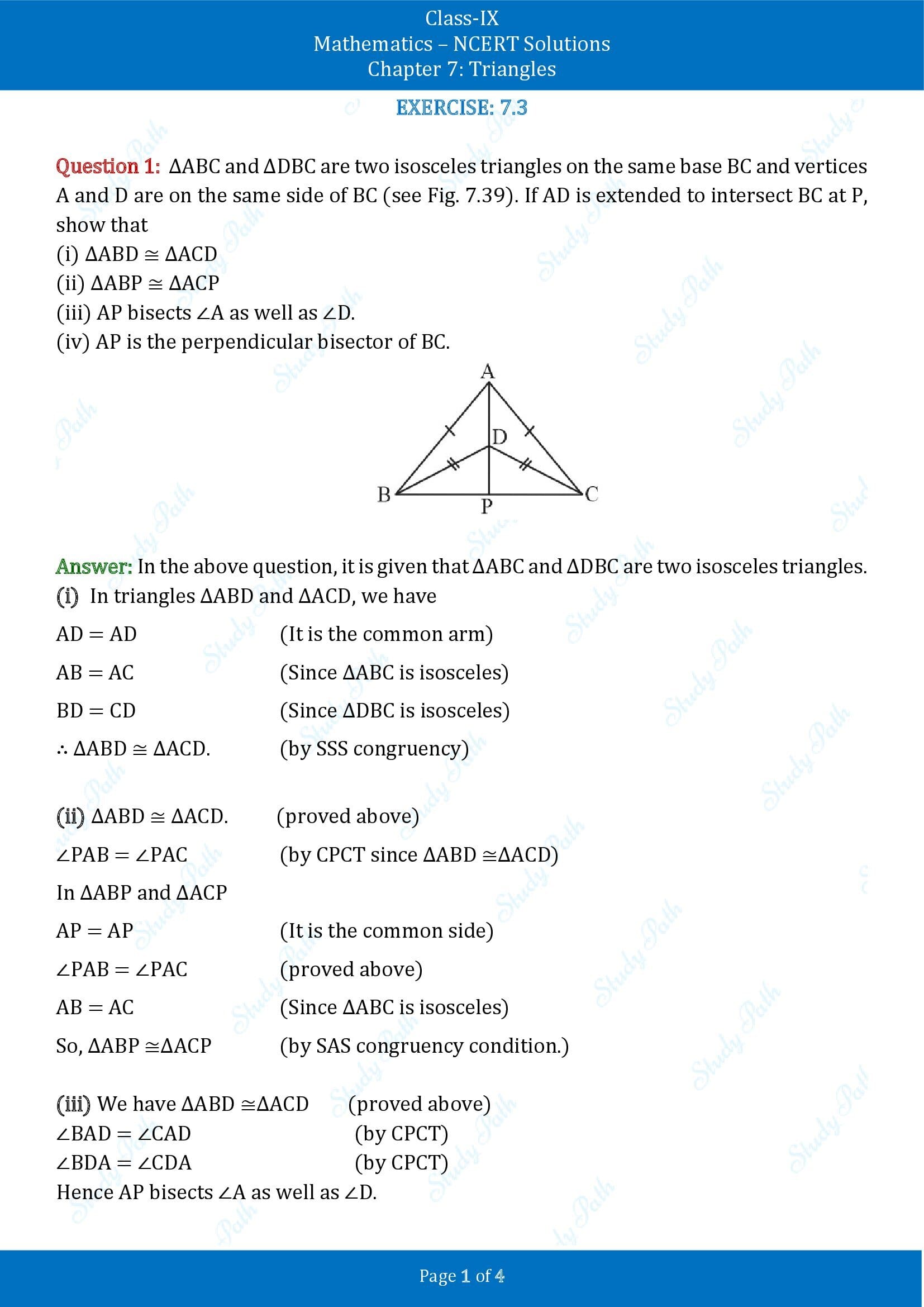
NCERT Solutions for Class 9 Maths Chapter 7 Exercise 7.4
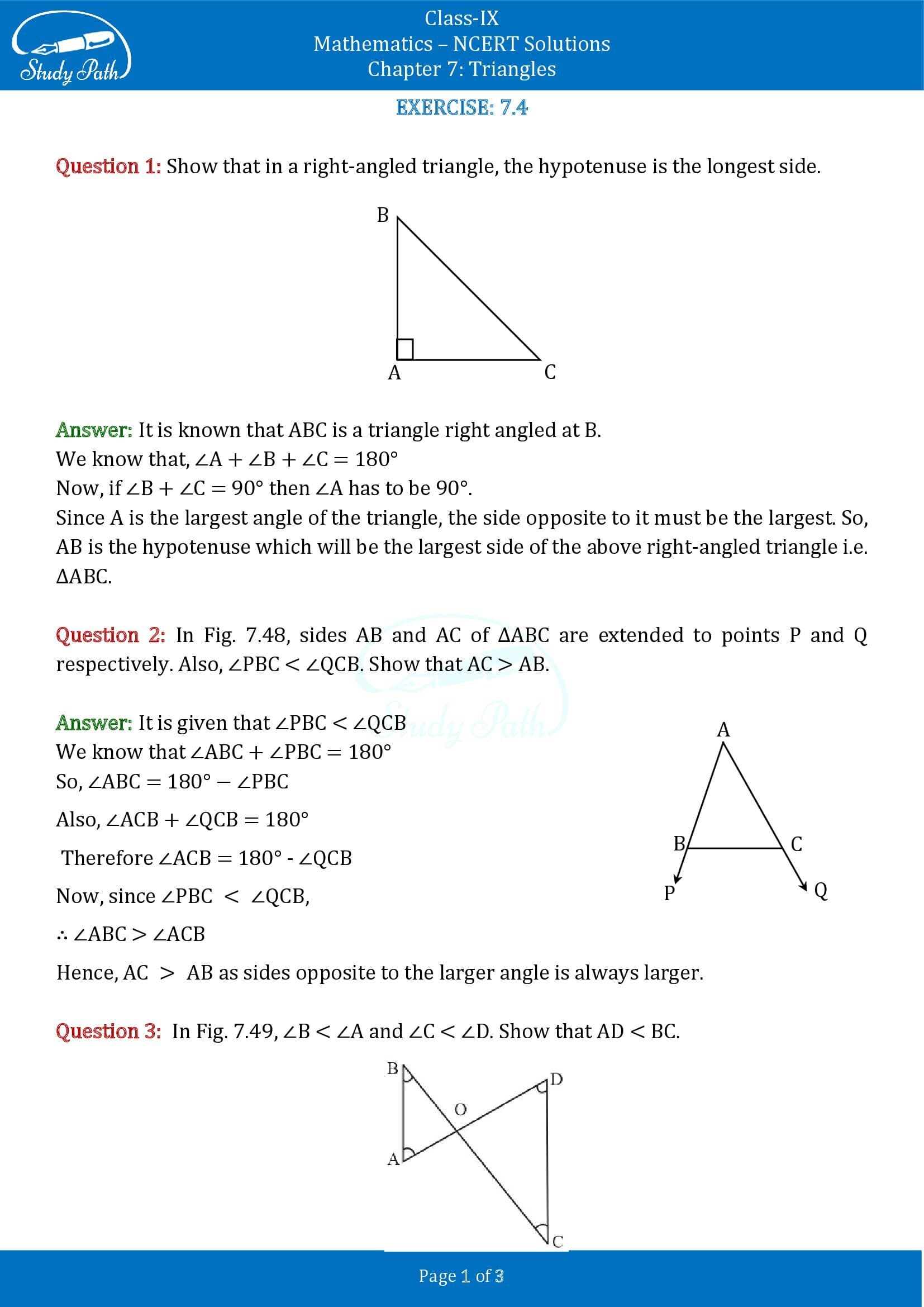
NCERT Solutions for Class 9 Maths Chapter 7 Exercise 7.5
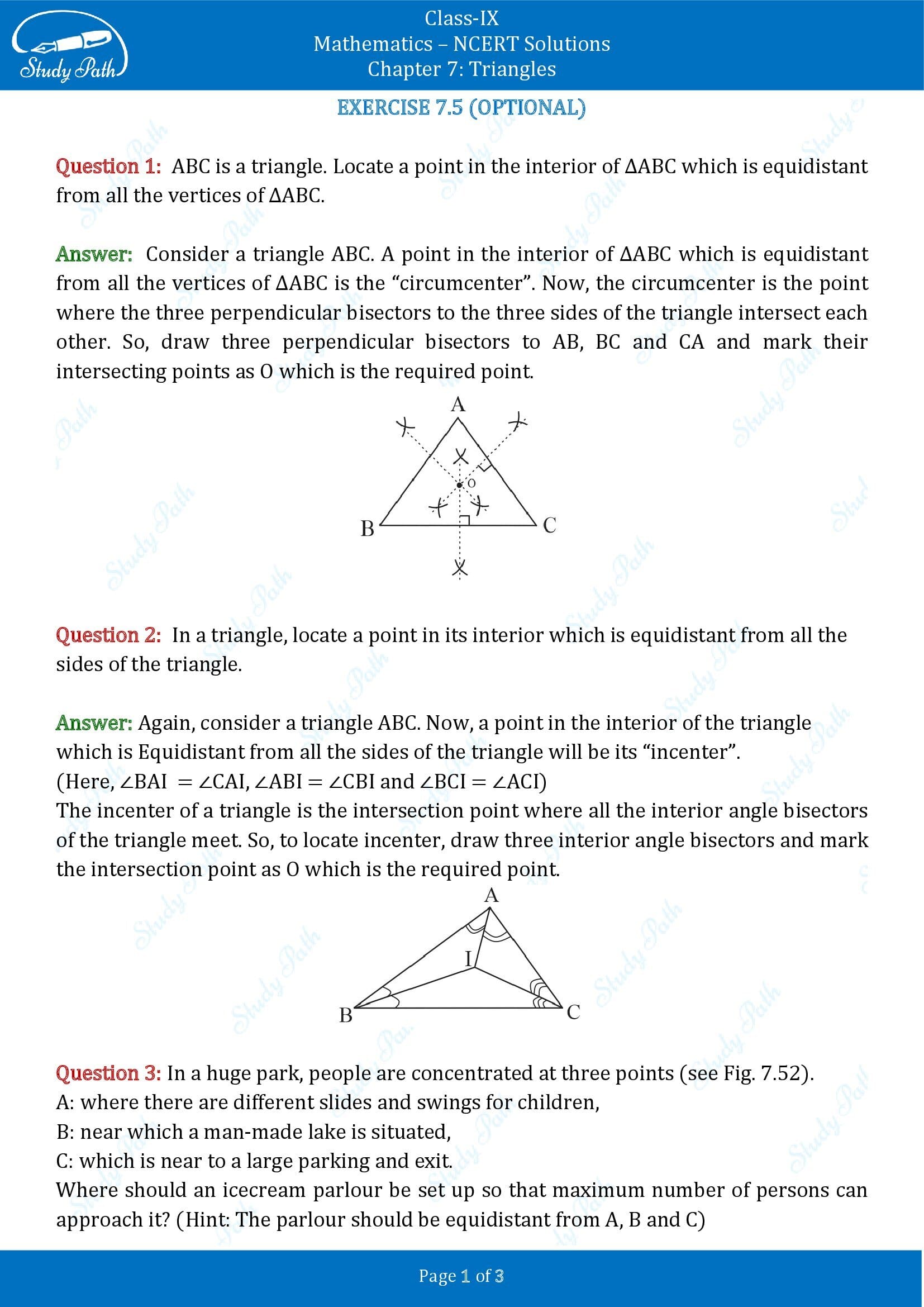
NCERT Solutions for Class 9 Maths Chapter 7 – Topic Discussion
Below we have listed the topics that have been discussed in this chapter.
- Congruence of triangles.
- Criteria for congruence of triangles (SAS congruence rule, ASA congruence rule, SSS congruence rule, RHS congruence rule).
- Properties of triangles.
- Inequalities of triangle.
Leave a Reply Cancel reply
Your email address will not be published. Required fields are marked *
Save my name, email, and website in this browser for the next time I comment.
- CBSE- Triangles
- Sample Questions
Triangles-Sample Questions
- STUDY MATERIAL FOR CBSE CLASS 9 MATH
- Chapter 1 - Area of Parallelograms and Triangles
- Chapter 2 - Circles
- Chapter 3 - Constructions
- Chapter 4 - Coordinate Geometry
- Chapter 5 - Herons Formula
- Chapter 6 - Introduction to Euclids Geometry
- Chapter 7 - Linear Equations in two variables
- Chapter 8 - Lines and Angles
- Chapter 9 - Number Systems
- Chapter 10 - Polynomials
- Chapter 11 - Probability
- Chapter 12 - Quadrilaterals
- Chapter 13 - Statistics
- Chapter 14 - Surface Areas and Volumes
- Chapter 15 - Triangles

NCERT Solutions for Class 9 Maths Chapter 7 Triangles
Ncert solutions for class 9 maths chapter 7 triangles| pdf download.

Page No: 118

- Exercise 7.1 Chapter 7 Class 9 Maths NCERT Solutions
- Exercise 7.2 Chapter 7 Class 9 Maths NCERT Solutions
- Exercise 7.3 Chapter 7 Class 9 Maths NCERT Solutions
- Exercise 7.4 Chapter 7 Class 9 Maths NCERT Solutions
- Exercise 7.5 Chapter 7 Class 9 Maths NCERT Solutions
NCERT Solutions for Class 9 Maths Chapters:
How many exercises in chapter 7 triangles, each of the equal angles of an isosceles triangle is 38°, what is the measure of the third angle, find the measure of each of acute angle in a right angle isosceles triangle., if two angles are (30 ∠ a)º and (125 + 2a)º and they are supplement of each other. find the value of ‘a’., contact form.
CBSE NCERT Solutions
NCERT and CBSE Solutions for free
Class 9 Mathematics Triangles Worksheets
We have provided below free printable Class 9 Mathematics Triangles Worksheets for Download in PDF. The worksheets have been designed based on the latest NCERT Book for Class 9 Mathematics Triangles . These Worksheets for Grade 9 Mathematics Triangles cover all important topics which can come in your standard 9 tests and examinations. Free printable worksheets for CBSE Class 9 Mathematics Triangles , school and class assignments, and practice test papers have been designed by our highly experienced class 9 faculty. You can free download CBSE printable worksheets for Mathematics Triangles Class 9 with solutions and answers. All worksheets and test sheets have been prepared by expert teachers as per the latest Syllabus in Mathematics Triangles Class 9. Students can click on the links below and download all Pdf worksheets for Mathematics Triangles class 9 for free. All latest Kendriya Vidyalaya Class 9 Mathematics Triangles Worksheets with Answers and test papers are given below.
Mathematics Triangles Class 9 Worksheets Pdf Download
Here we have the biggest database of free CBSE NCERT KVS Worksheets for Class 9 Mathematics Triangles . You can download all free Mathematics Triangles worksheets in Pdf for standard 9th. Our teachers have covered Class 9 important questions and answers for Mathematics Triangles as per the latest curriculum for the current academic year. All test sheets question banks for Class 9 Mathematics Triangles and CBSE Worksheets for Mathematics Triangles Class 9 will be really useful for Class 9 students to properly prepare for the upcoming tests and examinations. Class 9th students are advised to free download in Pdf all printable workbooks given below.
Topicwise Worksheets for Class 9 Mathematics Triangles Download in Pdf

Advantages of Solving Class 9 Mathematics Triangles Worksheets
- As we have the best collection of Mathematics Triangles worksheets for Grade 9, you will be able to find important questions which will come in your class tests and examinations.
- You will be able to revise all important and difficult topics given in your CBSE Mathematics Triangles textbooks for Class 9 .
- All Mathematics Triangles worksheets for standard 9 have been provided with solutions. You will be able to solve them yourself and them compare with the answers provided by our teachers.
- Class 9 Students studying in per CBSE, NCERT and KVS schools will be able to free download all Mathematics Triangles chapter wise assgnments and worksheets for free in Pdf
- Class 9 Mathematics Triangles Workbook will help to enhance and improve subject knowledge which will help to get more marks in exams
Frequently Asked Questions by Class 9 Mathematics Triangles students
At https://www.cbsencertsolutions.com, we have provided the biggest database of free worksheets for Mathematics Triangles Class 9 which you can download in Pdf
We provide here Standard 9 Mathematics Triangles chapter-wise worksheets which can be easily downloaded in Pdf format for free.
You can click on the links above and get worksheets for Mathematics Triangles in Grade 9, all topic-wise question banks with solutions have been provided here. You can click on the links to download in Pdf.
We have provided here subject-wise Mathematics Triangles Grade 9 question banks, revision notes and questions for all difficult topics, and other study material.
We have provided the best quality question bank for Class 9 for all subjects. You can download them all and use them offline without the internet.
Related Posts

Class 9 Social Science History Worksheets

Class 9 Sanskrit Worksheets

Class 9 Social Science Economics Worksheets
- NCERT Solutions
- NCERT Class 9
- NCERT 9 Maths
- Chapter 7: Geometry Of Triangles
- Exercise 7.1
NCERT Solutions for Class 9 Maths Chapter 7 Triangles Exercise 7.1
Exercise 7.1 of Chapter 7 of NCERT Class 9 Maths deals with the “Congruence of Triangles”. You must be wondering why this topic has been included in the syllabus, although we rarely see its applications. Well, in real life, two triangles are rarely congruent. However, studying this topic becomes crucial because it is used in the construction of large buildings or other architectural designs. Mathematicians have found the Triangle to be a very stable shape, and congruence is needed to create even surfaces. Also, you must have noticed congruent triangles in geometric art, carpeting designs, stepping stone designs, architectural designs, etc. Thus, this chapter plays a major role in daily life, and students have to focus on it using NCERT Solutions .
The NCERT Class 9 Maths Exercise is full of proof. Therefore, it’s important that you first know theorems related to it and then go for the exercise questions. Here, we have provided step-by-step NCERT Solutions for Class 9 Maths Chapter 7 Triangles Exercise 7.1. Students can refer to it whenever they find difficulty in solving the questions. The NCERT Class 9 Maths solutions are created by the subject experts and are solved in a simple way. These solutions will also help learn to answer complex questions so that students can score high marks in the annual exams. You can download the NCERT Solution PDF from the link below.
NCERT Solutions for Class 9 Maths Chapter 7 – Triangles Exercise 7.1
carouselExampleControls112

Previous Next
Access other Exercise Solutions of Chapter 7 – Triangles
You should practise all the questions of Exercise 7.1. To get the detailed solutions of all the exercises of NCERT Class 9 Chapter 7, visit the links provided below:
Exercise 7.2 Solution 8 Questions (6 Short Answer Questions, 2 Long Answer Question)
Exercise 7.3 Solution 5 Questions (3 Short Answer Questions, 2 Long Answer Question)
Exercise 7.4 Solution 6 Questions (5 Short Answer Questions, 1 Long Answer Question)
Exercise 7.5 (Optional) Solution 4 Questions
Access Answers to NCERT Solutions for Class 9 Maths Chapter 7 – Triangles Exercise 7.1
1. In quadrilateral ACBD, AC = AD and AB bisect ∠A (see Fig. 7.16). Show that ΔABC≅ ΔABD. What can you say about BC and BD?

It is given that AC and AD are equal i.e. AC = AD and the line segment AB bisects ∠A.
We will have to now prove that the two triangles ABC and ABD are similar i.e. ΔABC ≅ ΔABD
Consider the triangles ΔABC and ΔABD,
(i) AC = AD (It is given in the question)
(ii) AB = AB (Common)
(iii) ∠CAB = ∠DAB (Since AB is the bisector of angle A)
So, by SAS congruency criterion , ΔABC ≅ ΔABD.
For the 2 nd part of the question, BC and BD are of equal lengths by the rule of C.P.C.T.
2. ABCD is a quadrilateral in which AD = BC and ∠DAB = ∠CBA (see Fig. 7.17). Prove that
(i) ΔABD ≅ ΔBAC
(ii) BD = AC
(iii) ∠ ABD = ∠ BAC.

The given parameters from the questions are ∠ DAB = ∠ CBA and AD = BC.
(i) ΔABD and ΔBAC are similar by SAS congruency as
AB = BA (It is the common arm)
∠ DAB = ∠ CBA and AD = BC (These are given in the question)
So, triangles ABD and BAC are similar i.e. ΔABD ≅ ΔBAC. (Hence proved).
(ii) It is now known that ΔABD ≅ ΔBAC so,
BD = AC (by the rule of CPCT).
(iii) Since ΔABD ≅ ΔBAC so,
Angles ∠ ABD = ∠ BAC (by the rule of CPCT).
3. AD and BC are equal perpendiculars to a line segment AB (see Fig. 7.18). Show that CD bisects AB.

It is given that AD and BC are two equal perpendiculars to AB.
We will have to prove that CD is the bisector of AB
Triangles ΔAOD and ΔBOC are similar by AAS congruency since:
(i) ∠A = ∠B (They are perpendiculars)
(ii) AD = BC (As given in the question)
(iii) ∠AOD = ∠BOC (They are vertically opposite angles)
∴ ΔAOD ≅ ΔBOC.
So, AO = OB (by the rule of CPCT).
Thus, CD bisects AB (Hence proved).
4. l and m are two parallel lines intersected by another pair of parallel lines p and q (see Fig. 7.19). Show that ΔABC ≅ ΔCDA.

It is given that p || q and l || m
Triangles ABC and CDA are similar i.e. ΔABC ≅ ΔCDA
Consider the ΔABC and ΔCDA,
(i) ∠BCA = ∠DAC and ∠BAC = ∠DCA Since they are alternate interior angles
(ii) AC = CA as it is the common arm
So, by ASA congruency criterion, ΔABC ≅ ΔCDA.
5. Line l is the bisector of an angle ∠A and B is any point on l . BP and BQ are perpendiculars from B to the arms of ∠A (see Fig. 7.20). Show that:
(i) ΔAPB ≅ ΔAQB
(ii) BP = BQ or B is equidistant from the arms of ∠A.

It is given that the line “ l ” is the bisector of angle ∠A and the line segments BP and BQ are perpendiculars drawn from l .
(i) ΔAPB and ΔAQB are similar by AAS congruency because:
∠P = ∠Q (They are the two right angles)
AB = AB (It is the common arm)
∠BAP = ∠BAQ (As line l is the bisector of angle A)
So, ΔAPB ≅ ΔAQB.
(ii) By the rule of CPCT, BP = BQ. So, it can be said the point B is equidistant from the arms of ∠A.
6. In Fig. 7.21, AC = AE, AB = AD and ∠BAD = ∠EAC. Show that BC = DE.

It is given in the question that AB = AD, AC = AE, and ∠BAD = ∠EAC
The line segment BC and DE are similar i.e. BC = DE
We know that ∠BAD = ∠EAC
Now, by adding ∠DAC on both sides we get,
∠BAD + ∠DAC = ∠EAC +∠DAC
This implies, ∠BAC = ∠EAD
Now, ΔABC and ΔADE are similar by SAS congruency since:
(i) AC = AE (As given in the question)
(ii) ∠BAC = ∠EAD
(iii) AB = AD (It is also given in the question)
∴ Triangles ABC and ADE are similar i.e. ΔABC ≅ ΔADE.
So, by the rule of CPCT, it can be said that BC = DE.
7. AB is a line segment and P is its mid-point. D and E are points on the same side of AB such that ∠BAD = ∠ABE and ∠EPA = ∠DPB (see Fig. 7.22). Show that
(i) ΔDAP ≅ ΔEBP
(ii) AD = BE

In the question, it is given that P is the mid-point of line segment AB. Also, ∠BAD = ∠ABE and ∠EPA = ∠DPB
(i) It is given that ∠EPA = ∠DPB
Now, add ∠DPE on both sides,
∠EPA +∠DPE = ∠DPB+∠DPE
This implies that angles DPA and EPB are equal i.e. ∠DPA = ∠EPB
Now, consider the triangles DAP and EBP.
∠DPA = ∠EPB
AP = BP (Since P is the mid-point of the line segment AB)
∠BAD = ∠ABE (As given in the question)
So, by ASA congruency , ΔDAP ≅ ΔEBP.
(ii) By the rule of CPCT, AD = BE.
8. In right triangle ABC, right angled at C, M is the mid-point of hypotenuse AB. C is joined to M and produced to a point D such that DM = CM. Point D is joined to point B (see Fig. 7.23). Show that:
(i) ΔAMC ≅ ΔBMD
(ii) ∠DBC is a right angle.
(iii) ΔDBC ≅ ΔACB
(iv) CM = ½ AB

It is given that M is the mid-point of the line segment AB, ∠C = 90°, and DM = CM
(i) Consider the triangles ΔAMC and ΔBMD:
AM = BM (Since M is the mid-point)
CM = DM (Given in the question)
∠CMA = ∠DMB (They are vertically opposite angles)
So, by SAS congruency criterion , ΔAMC ≅ ΔBMD.
(ii) ∠ACM = ∠BDM (by CPCT)
∴ AC || BD as alternate interior angles are equal.
Now, ∠ACB +∠DBC = 180° (Since they are co-interiors angles)
⇒ 90° +∠B = 180°
∴ ∠DBC = 90°
(iii) In ΔDBC and ΔACB,
BC = CB (Common side)
∠ACB = ∠DBC (They are right angles)
DB = AC (by CPCT)
So, ΔDBC ≅ ΔACB by SAS congruency .
(iv) DC = AB (Since ΔDBC ≅ ΔACB)
⇒ DM = CM = AM = BM (Since M the is mid-point)
So, DM + CM = BM+AM
Hence, CM + CM = AB
⇒ CM = (½) AB
The students of Class 9 will learn the concepts of Congruence of Triangles, the Criteria for Congruence and the theorem related to it in Exercise 7.1. In the exercise, the questions are related to the proof. So, while solving these questions, it’s very important that students should mention the congruence rule. Also, they should not miss any steps while solving it. To know how to write answers in a better way to score good marks, download the NCERT solution PDF.
We hope this information on “ NCERT Solution Class 9 Maths Chapter 7 Triangles Exercise 7.1” is useful for students.
Click on NCERT Solutions to get the solved answers from the NCERT book for all the classes. Stay tuned for further updates on CBSE and other competitive exams. To access interactive Maths and Science Videos, download the BYJU’S App and subscribe to our YouTube Channel.
Thank you for your help this really helped me.
- Share Share
Register with BYJU'S & Download Free PDFs
Register with byju's & watch live videos.

Counselling
CBSE Expert
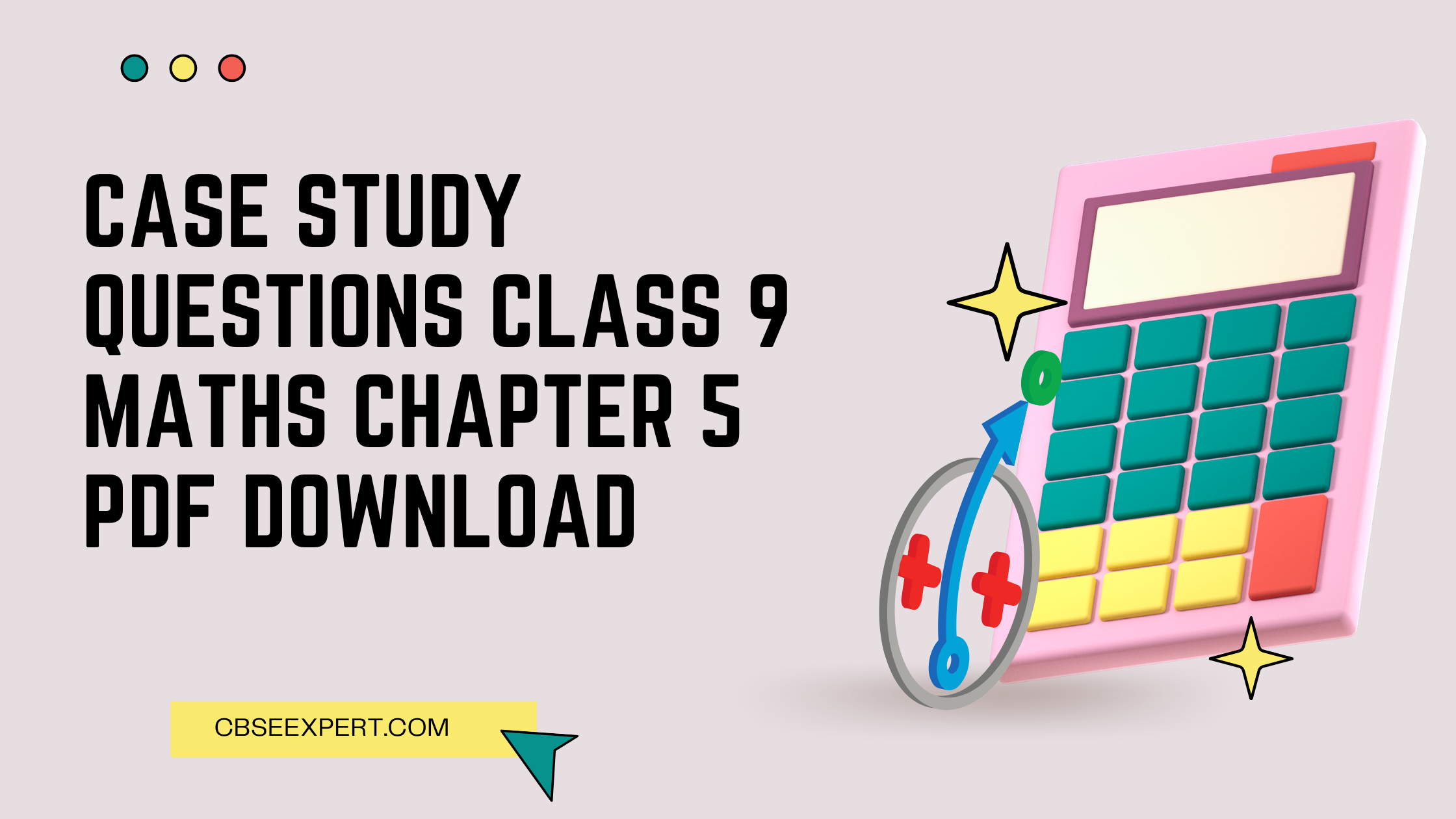
CBSE Case Study Questions Class 9 Maths Chapter 5 Introduction to Euclid’s Geometry PDF Download
Case Study Questions Class 9 Maths Chapter 5 Introduction to Euclid’s Geometry is very important to solve for your exam. Class 9 Maths Chapter 5 Case Study Questions have been prepared for the latest exam pattern. You can check your knowledge by solving case study-based questions for Class 9 Maths Chapter 5 Introduction to Euclid’s Geometry

CBSE Case Study Questions for Class 9 Maths Euclids Geometry PDF
Case study questions class 9 maths chapter 5.
Case Study 1: In a mathematics class, students were learning about Euclid’s Geometry and the properties of lines and angles. The teacher drew the following figure on the board:
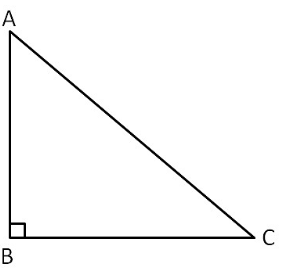
Using this figure, the teacher presented some statements and asked the students to determine whether they were true or false. Let’s see how well you can answer these questions:
Q1. In triangle ABC, if AB = AC, then the triangle is: (a) Equilateral (b) Isosceles (c) Scalene (d) Right-angled
Answer: (b) Isosceles
Q2. If lines AB and AC are perpendicular to each other, then the measure of angle BAC is: (a) 45 degrees (b) 90 degrees (c) 180 degrees (d) It cannot be determined
Answer: (b) 90 degrees
Q3. In triangle ABC, if angle B = angle C, then the triangle is: (a) Equilateral (b) Isosceles (c) Scalene (d) Right-angled
Q4. In triangle ABC, if angle B = angle C = 60 degrees, then the triangle is: (a) Equilateral (b) Isosceles (c) Scalene (d) Right-angled
Answer: (a) Equilateral
Q5. In triangle ABC, if AB = BC, then the triangle is: (a) Equilateral (b) Isosceles (c) Scalene (d) Right-angled
Case Study 2. A group of students is studying geometrical shapes and their properties. They came across the following figure:
The students were given statements related to this figure and were asked to determine whether they were true or false. Let’s see if you can answer these questions:
Q1. In the given figure, line segment AB is perpendicular to line segment CD. True or False?
Answer: (b) False
Q2. In the given figure, angle CAB is supplementary to angle BCD. True or False?
Q3. In the given figure, angle CAD is complementary to angle BCD. True or False?
Q4. In the given figure, line segments AC and BD are parallel. True or False?
Answer: (a) True
Q5. In the given figure, angle CAD is equal to angle CDB. True or False?
Case Study 3. A group of students was learning about the properties of quadrilaterals. The teacher presented them with the following figure:
The teacher then asked the students to identify the type of quadrilateral based on its properties. Let’s see if you can answer the questions correctly:
Q1. In the given figure, if all four sides of the quadrilateral ABCD are equal, then it is a: (a) Rectangle (b) Rhombus (c) Square (d) Parallelogram
Answer: (b) Rhombus
Q2. In the given figure, if opposite sides of the quadrilateral ABCD are parallel, then it is a: (a) Rectangle (b) Rhombus (c) Square (d) Parallelogram
Answer: (d) Parallelogram
Q3. In the given figure, if opposite angles of the quadrilateral ABCD are equal, then it is a: (a) Rectangle (b) Rhombus (c) Square (d) Parallelogram
Q4. In the given figure, if all four angles of the quadrilateral ABCD are right angles, then it is a: (a) Rectangle (b) Rhombus (c) Square (d) Parallelogram
Answer: (a) Rectangle
Q5. In the given figure, if all four sides of the quadrilateral ABCD are equal and all four angles are right angles, then it is a: (a) Rectangle (b) Rhombus (c) Square (d) Parallelogram
Answer: (c) Square
Hope the information shed above regarding Case Study and Passage Based Questions for Case Study Questions Class 9 Maths Chapter 5 Introduction to Euclid’s Geometry with Answers Pdf free download has been useful to an extent. If you have any other queries about Case Study Questions Class 9 Maths Chapter 5 Introduction to Euclid’s Geometry and Passage-Based Questions with Answers, feel free to comment below so that we can revert back to us at the earliest possible.
Leave a Comment Cancel reply
Save my name, email, and website in this browser for the next time I comment.
Download India's best Exam Preparation App Now.
Key Features
- Revision Notes
- Important Questions
- Previous Years Questions
- Case-Based Questions
- Assertion and Reason Questions
No thanks, I’m not interested!
CBSE MCQ for Class 9 Maths Chapter 7 Triangles Free PDF

Guys, we are working very hard to provide you with TOPIC-WISE MCQs (as listed below). Till then, attached below is the Master PDF having all the topics. Hope you understand. Enjoy your preparation! All the Best!
CBSE MCQ for Class 9 Maths Chapter 7 Triangles PDF
The CBSE MCQ for Class 9 Maths Chapter 7 Triangles are provided above, in detailed and free to download PDF format. The solutions are latest , comprehensive , confidence inspiring , with easy to understand explanation . To download NCERT Class 9 Solutions PDF for Free, just click ‘ Download pdf ’.
Other MCQ Questions for Maths Class 9th CBSE
- CBSE MCQ for Class 9 Maths Chapter 5 Euclid’s Geometry
- CBSE MCQ for Class 9 Maths Chapter 6 Lines and Angles
- CBSE MCQ for Class 9 Maths Chapter 8 Quadrilaterals
- CBSE MCQ for Class 9 Maths Chapter 9 Areas of Parallelograms and Triangles
How should I study for my upcoming exams?
First, learn to sit for at least 2 hours at a stretch
Solve every question of NCERT by hand, without looking at the solution.
Solve NCERT Exemplar (if available)
Sit through chapter wise FULLY INVIGILATED TESTS
Practice MCQ Questions (Very Important)
Practice Assertion Reason & Case Study Based Questions
Sit through FULLY INVIGILATED TESTS involving MCQs. Assertion reason & Case Study Based Questions
After Completing everything mentioned above, Sit for atleast 6 full syllabus TESTS.
Contact Form
Privacy Policy

IMAGES
VIDEO
COMMENTS
Answer: (a) 30 degrees. Q5. The lengths of the two equal sides of the kite triangle are: (a) 3 units each. (b) 4 units each. (c) 5 units each. (d) It cannot be determined. Answer: (c) 5 units each. Hope the information shed above regarding Case Study and Passage Based Questions for Case Study Questions Class 9 Maths Chapter 7 Triangles with ...
CBSE Class 9 Maths Question Bank on Case Studies given in this article can be very helpful in understanding the new format of questions. Each question has five sub-questions, each followed by four options and one correct answer. Students can easily download these questions in PDF format and refer to them for exam preparation. Case Study Questions.
Download Class 9 Maths Case Study Questions to prepare for the upcoming CBSE Class 9 Exams 2023-24. These Case Study and Passage Based questions are published by the experts of CBSE Experts for the students of CBSE Class 9 so that they can score 100% in Exams. Case study questions play a pivotal role in enhancing students' problem-solving skills.
Case Study Questions for Class 9 Maths Chapter 7 Triangles Here we are providing case study questions for Class 9 Maths Chapter 7 Triangles. Students are suggested to solve the questions by themselves first and then check the answers. This will help students to check their grasp on this particular chapter Triangles. Case Study Questions: … Continue reading Case Study Questions for Class 9 ...
Introduction of CBSE Case Study Questions for Class 9 Maths - Pdf in English is available as part of our Class 9 preparation & CBSE Case Study Questions for Class 9 Maths - Pdf in Hindi for Class 9 courses. Download more important topics, notes, lectures and mock test series for Class 9 Exam by signing up for free.
CBSE Class 9 Maths Board Exam will have a set of questions based on case studies in the form of MCQs.The CBSE Class 9 Mathematics Question Bank on Case Studies, provided in this article, can be very helpful to understand the new format of questions. Share this link with your friends. If you want to want to prepare all the tough, tricky & difficult questions for your upcoming exams, this is ...
Case Study Questions Class 9 Maths Chapter 9 Areas of Parallelograms and Triangles are very important to solve for your exam. Class 9 Maths Chapter 9 Case Study Questions have been prepared for the latest exam pattern. You can check your knowledge by solving case study-based questions for Class 9 Maths Chapter 9 Areas of Parallelograms and Triangles
Class 9 Mathematics Case study question 2. Read the Source/Text given below and answer any four questions: Maths teacher draws a straight line AB shown on the blackboard as per the following figure. Now he told Raju to draw another line CD as in the figure. The teacher told Ajay to mark ∠ AOD as 2z.
Triangles Case Study Questions (CSQ's) Practice Tests. Timed Tests. Select the number of questions for the test: TopperLearning provides a complete collection of case studies for CBSE Class 9 Maths Triangles chapter. Improve your understanding of biological concepts and develop problem-solving skills with expert advice.
Of the three angles of the triangle, one is twice the smallest and another one is thrice the smallest. Find the angles. (Answer: 60°, 90°, 30°) If each of a triangle is less than the sum of the other two, show that the triangle is acute-angled. The sum of two angles of a triangle is 116° and their difference is 24.
The questions in this exercise require students to apply the criteria for the similarity of triangles such as AA, SAS, and SSS. The questions require students to find the values of the sides and angles of similar triangles. Access NCERT Answers for Class-9 Maths Chapter 7 - Triangles. Exercise-7.1. 1.
@mathscluster5737 Case study based questions for class 9 maths CBSE board Case study based questions of chapter Congruence of triangles Congruence of triang...
Case Study Questions for Class 9 Maths Archives - Gurukul of Excellence. Q-104, Sector-38, Gurgaon, Haryana 07065827902 [email protected] M-F: 8 AM- 8 PM; Weekend: 10 AM-2 PM.
CLASS 09 - MATHEMATICS Question Paper Time Allowed: 59 minutes Maximum Marks: 200 Section A 1. A die is thrown 500 times and the outcomes arenoted as given below: Outcome 1 2 Frequency 95 80 If a die is thrown at random, find the probabilityi. 1of getting ii. 2 iii. 3 iv. 4 v. 5 vi. 6. 2. On one page of a telephone directory, there were200 ...
The NCERT solutions class 9 maths chapter 7 contains important theorems, definitions, terms, and rules related to congruence in triangles that students must memorize. Some of these criteria are SAS, ASA, SSS, and RHS congruence rules. Some other important concepts included in these solutions are the angle sum property stating that the sum of ...
Here you will get complete NCERT Solutions for Class 9 Maths Chapter 7 all exercises Exercise in one place. These solutions are prepared by the subject experts and as per the latest NCERT syllabus and guidelines. CBSE Class 9 Students who wish to score good marks in the maths exam must practice these questions regularly.
NCERT Book Class 9 Maths Chapter 7 Triangles PDF. The direct link to download class 9 Maths NCERT Book PDF for chapter 7 Triangles is given above. However if you want to read the complete lesson on Triangles then that is also possible here at aglasem. So here is the complete class 9 Maths Ch 7 Triangles.
Class IX TrianglesSAMPLE PAPER. 1. Prove that angles opposite to equal sides of an isosceles triangle are equal. 2. In a triangle ABC, E and F respectively are mid-points of equal sides AB and AC of ΔABC. Show that BF = CE. 3. AD is an altitude of an isosceles ΔABC in which AB = AC. Show that AD bisects BC.
Find the measure of each of acute angle in a right angle isosceles triangle. Let the measure of each of the equal acute angle of the Δ be x. ∴ We have: x + x + 90° = 180°. ⇒ x + x = 180° - 90° = 90°. ⇒ x= (90°/2)= 45°. If two angles are (30 ∠ a)º and (125 + 2a)º and they are supplement of each other.
We have provided below free printable Class 9 Mathematics Triangles Worksheets for Download in PDF. The worksheets have been designed based on the latest NCERT Book for Class 9 Mathematics Triangles. These Worksheets for Grade 9 Mathematics Triangles cover all important topics which can come in your standard 9 tests and examinations.
EXERCISE 7.1 CLASS 9 MATHS CHAPTER 7-TRIANGLES: NCERT Solutions for Class 9 Maths Chapter 7 Triangles Ex 7.1 in PDF format for Free. Download now by registering with BYJU'S.
CBSE Case Study Questions for Class 9 Maths Euclids Geometry PDF Case Study Questions Class 9 Maths Chapter 5. Case Study 1: In a mathematics class, students were learning about Euclid's Geometry and the properties of lines and angles.The teacher drew the following figure on the board:
The CBSE MCQ for Class 9 Maths Chapter 7 Triangles are provided above, in detailed and free to download PDF format. The solutions are latest, comprehensive, confidence inspiring, with easy to understand explanation. To download NCERT Class 9 Solutions PDF for Free, just click ' Download pdf '.